

Trek Slash C Gen 5 manual

user manual Trek Slash C Gen 5

202 1 SLASH CARBON & ALLOY
Service manual supplement.

User manual

View the manual for the Trek Slash C Gen 5 here, for free. This manual comes under the category bicycles and has been rated by 1 people with an average of a 9.1. This manual is available in the following languages: English. Do you have a question about the Trek Slash C Gen 5 or do you need help? Ask your question here
Do you have a question about the Trek and is the answer not in the manual?
- Receive updates on solutions
- Get answers to your question
Question and answer

The Trek Slash C Gen 5 is a high-performance mountain bike designed for off-road enthusiasts in the United Kingdom. With its advanced features and sturdy construction, this bike offers a reliable and durable ride on various terrains. Featuring a lightweight carbon frame, the Trek Slash C Gen 5 offers both strength and agility. The carbon material ensures enhanced performance while keeping the weight to a minimum, allowing riders to easily navigate through challenging trails. Equipped with a suspension system, this bike absorbs shocks effectively, providing a smooth and comfortable riding experience. The suspension system works in conjunction with the bike's 29-inch wheels, which offer improved traction and stability on uneven surfaces. The Trek Slash C Gen 5 includes top-quality components such as a precision-engineered drivetrain, powerful hydraulic disc brakes, and reliable tires. These components ensure precise gear shifting, reliable stopping power, and excellent grip, enhancing the overall performance of the bike. Designed with the specific needs of mountain bikers in mind, this bike offers a balanced geometry and ergonomic design, promoting efficient pedaling and comfortable positioning. Additionally, the bike's sleek and stylish appearance adds to its appeal. Whether you are a professional mountain biker or simply enjoy off-road adventures, the Trek Slash C Gen 5 provides an exceptional riding experience. Its advanced features, reliable components, and durable construction make it an excellent choice for tackling challenging trails in the United Kingdom.
Can't find the answer to your question in the manual? You may find the answer to your question in the FAQs about the Trek Slash C Gen 5 below.
How do I remove rust from my Trek bicycle?
1. Soak the rusty part in vinegar until completely soaked through. 2. Let the vinegar work on the rust for 24 hours. 3. Remove the rust with a wire brush or aluminium foil.
How much should I exercise as an adult per week?
As an adult, it is recommended to do moderately intensive exercise for at least 2.5 hours per week. Preferably spread over several days.
Is the manual of the Trek Slash C Gen 5 available in English?
Yes, the manual of the Trek Slash C Gen 5 is available in English .
Is your question not listed? Ask your question here

Trek Rail 5 Gen 2

Trek Powerfly 4 Gen 4

Trek Powerfly 5 Gen 4

Trek Rail 5 Gen 3

Trek Domane SL 6 Gen 3

Trek Domane SL 6 Gen 4

Trek Powerfly 4 Gen 3

Trek Slash AL Gen 5

Trek Marlin 6 Gen 3

Trek Powerfly FS 4 Gen 2

Trek Quadro Slash C manual

manual Trek Quadro Slash C

View the manual for the Trek Quadro Slash C here, for free. This manual comes under the category bicycles and has been rated by 1 people with an average of a 7.4. This manual is available in the following languages: English. Do you have a question about the Trek Quadro Slash C or do you need help? Ask your question here
Do you have a question about the Trek and is the answer not in the manual?
- Receive updates on solutions
- Get answers to your question
Question and answer

Can't find the answer to your question in the manual? You may find the answer to your question in the FAQs about the Trek Quadro Slash C below.
How do I remove rust from my Trek bicycle?
1. Soak the rusty part in vinegar until completely soaked through. 2. Let the vinegar work on the rust for 24 hours. 3. Remove the rust with a wire brush or aluminium foil.
How much should I exercise as an adult per week?
As an adult, it is recommended to do moderately intensive exercise for at least 2.5 hours per week. Preferably spread over several days.
Is the manual of the Trek Quadro Slash C available in English?
Yes, the manual of the Trek Quadro Slash C is available in English .
Is your question not listed? Ask your question here

Trek Slash C Gen 5

Trek Procaliber

Trek Domane+ SLR 7

Trek Speed Concept

Trek Powerfly 4 Gen 4

Trek Supercaliber

Trek Madone SL 7

Trek Slash AL Gen 5

Trek Checkpoint ALR 5

Trek Checkpoint SL
- Trek Manuals
- Slash Alloy and Carbon - Gen 6
- Service manual
Trek Slash Alloy and Carbon - Gen 6 Service Manual
- page of 23 Go / 23
Table of Contents
- Additional Resources
- Adjustable Headset
- Idler Pulley
- Rear Fender
- Specifications
Advertisement
Quick Links
Related manuals for trek slash alloy and carbon - gen 6.

Summary of Contents for Trek Slash Alloy and Carbon - Gen 6
- Page 1 Slash Alloy and Carbon — Gen 6 SERVICE MANUAL...
- Page 2 Downtube storage chain guards chain guards Change: rear wheel headset angle 29" progression 27.5" Change to a 29” Adjust the Adjust the rear wheel headset angle progression Torque Specs order Torque order Specifications Copyright 2023 Trek Bicycle Corporation All Rights Reserved...
Page 3: Additional Resources
Page 4: adjustable headset, page 5: idler pulley.
- Page 6 Slash Alloy and Carbon — Gen 6 Active Braking Pivot with Universal Derailleur Hanger Carbon frame Important: The lower chainguard (page 15 and page 16) must be fully installed before adjusting the derailleur. Alloy frame Derailleur hanger Thru axle, M12x167.35mm — W583469 NOTICE: Do not apply grease.
- Page 7 Slash Alloy and Carbon — Gen 6 Active Braking Pivot with SRAM Transmission Derailleur Carbon frame Important: The lower chainguard (page 15) must be fully installed before adjusting the derailleur. Thru axle, M12x167.35mm — W583469 Non-driveside ABP bolt — W5251141 Non-driveside ABP dropout nut —...
- Page 8 Slash Alloy and Carbon — Gen 6 Main pivot and chainstay See “Torque order” on page 10. Install driveside bearings first Chainstay* Carbon — 46192 Alloy — 46193 *Paint matched part. Sea trekbikes.com to find the color-matched part for your bike. Fastener, M6x25mm —...
- Page 9 Slash Alloy and Carbon — Gen 6 Rocker pivot and seatstay See “Torque order” on page 10. Install driveside bearing first Two-piece rocker pivot* Seatstay* Carbon — 46196 Carbon — 46194 Alloy — 46197 Alloy — 46195 Spacers, 4mm wide — W5305806 Fasteners, M10x21 —...
- Page 10 Slash Alloy and Carbon — Gen 6 Rear shock hardware See “Torque order” on page 10. See Change to a 29” rear wheel on page 19 for instructions on changing the lower shock mounts to switch to a 29" wheel on M-XL frames. Upper shock mount axle, M6x67 —...
- Page 11 Slash Alloy and Carbon — Gen 6 Torque order Important: Remove the bike from the bike stand and set it on the ground before torquing all fasteners to spec.
- Page 12 Slash Alloy and Carbon — Gen 6 Carbon routing with mechanical shift Molded-in cable tunnels Seatpost dropper cable housing Rear brake hose Shift cable housing Frame plug, 7mm — W5309145 Bolt-on cable guide, single — W311727* Fastener, M5x8mm — W596823 Bolt-on cable guide, double —...
- Page 13 Slash Alloy and Carbon — Gen 6 Carbon routing with AXS shift Molded-in cable tunnels Seatpost dropper cable housing Fastener, M5x8mm — W596823 Rear brake hose Bolt-on cable guide, double — W311726* Frame plug, 7mm — W5309145 Fastener, M5x10mm — W5252771 Frame plug, 6mm —...
- Page 14 Slash Alloy and Carbon — Gen 6 Alloy routing with mechanical shift Molded-in cable tunnels Seatpost dropper cable housing Rear brake hose Shift cable housing Frame plug — W5275264 Bolt-on cable guide, single — W311727* Fastener, M5x8mm — W596823 Bolt-on cable guide, double — W311726* Fastener, M5x10mm —...
- Page 15 Slash Alloy and Carbon — Gen 6 Alloy routing with AXS shift Molded-in cable tunnels Seatpost dropper cable housing Fastener, M5x8mm — W596823 Rear brake hose Bolt-on cable guide, double — W311726* Frame plug, 6mm — W5309144 Fastener, M5x10mm — W5252771 10 Frame plug —...
- Page 16 Slash Alloy and Carbon — Gen 6 Carbon frame and chain guards Bonded strike guards To improve adhesion, use sandpaper to roughen the backside of the guards and/or remove remnants of the old guard from the areas of the frame where epoxy will be applied. Attach the guards with a two-part epoxy.
- Page 17 Slash Alloy and Carbon — Gen 6 Alloy frame and chain guards Adhesive guard Use isopropyl alcohol to clean the frame surface where the guard attaches. Wait for the alcohol to dry before applying the guard. NOTICE: Do not clean the entire frame with isopropyl alcohol.
Page 18: Rear Fender
- Page 19 Slash Alloy and Carbon — Gen 6 Downtube storage Torque all fasteners to 1.5Nm Downtube storage assembly with matte black door — W5297657 Paint-matched storage door only — 46198 and 46199. See both part numbers on trekbikes.com to see all color options. Important: Also order 1 to receive the fasteners, lever and base.
- Page 20 Slash Alloy and Carbon — Gen 6 Change to a 29" rear wheel Size M-XL: To change to a 29" rear wheel, remove the 27.5" lower shock mounts and replace them with the 29" lower shock mounts. Size S: Is not compatible with a 29" rear wheel. Small frames use the same lower shock mounts as a 29" rear wheel, but 29" wheels do not fit on the small frames.
- Page 21 Slash Alloy and Carbon — Gen 6 Adjust the headset angle -1° 0° +1° Install the angled cups Grease the cups and head tube bores. Tools • Upper angled cup: S – M frames — W5295319 L – XL frames — W5295274 •...
- Page 22 Slash Alloy and Carbon — Gen 6 Adjust the progression The shock progression chip can be flipped to fine tune the shock performance for the terrain or rider preference. 20% Progression Softer 25% Progression Firmer More reactive to repeated fast More bottom-out resistance over mid-size bumps and square-edge hits big hits and drops...
Page 23: Specifications
Rename the bookmark, delete bookmark, delete from my manuals, upload manual.
Trek Slash Review | The all-new Slash is the iron fist in a velvet glove
The not-so-minor details.
Trek Slash 9.9 X01
Trek Bicycles Australia
https://www.trekbikes.com
$11,499 AUD
- Wickedly supple and sensitive suspension - Super stable in steep and rough terrain - The playful, agile attitude - Generous frame protection - Stealthy quiet on the trail
- Downtube storage could be more generous - We'd like to see a slightly steeper seat tube angle
Dan & Ben review the 2021 Trek Slash
Trek’s flagship enduro pinner, the Slash, is receiving a major and welcome overhaul for 2021. As the spiritual successor to the Remedy 29, the current Slash was released over four years ago. In that time the enduro racing scene has changed considerably. No longer are 29in wheels looked upon with concern and disdain. Nowadays, you’ll be hard-pressed to find an EWS team that isn’t rolling on 29in wheels. As the sport has professionalised, we’re seeing athletes train harder, race times get tighter, and courses that wouldn’t be out of place at a World Cup downhill race. Unlike DH racing though, enduro racers have to back up those race runs over multiple stages, often over multiple days, with hundreds and thousands of metres of climbing between the start and finish. Oh, and they’re regularly racing those trails blind too.
Watch our video review of the 2021 Trek Slash 9.9 here!


Trek Slash overview
Given the evolving demands of enduro racing, enduro bikes need to evolve too. Taking on board these changes, the new Trek Slash has had a 10mm lift in travel at both ends, and now features a 170mm fork matched to 160mm of rear wheel travel. Following requests from Trek’s EWS athletes, it also gets a bit slacker and longer as expected, which is to help it cope with the gnarlification of modern day enduro racing.
All of that is built around a brand new chassis that features in-built storage, a new Knock Block system, and a serious amount of battle armour. Along with the unique rear shock and adjustable geometry, Trek is making use of every tool in its disposal to produce what it says is the fastest and most technically proficient Slash yet.
For the past month we’ve been testing the top-end Slash 9.9 to see how all of those changes play out on the trail, and whether this newly refocussed enduro race bike is now more of a one-trick-pony. Before we get to our ride impressions though, let’s take a detailed look at what sets the Slash apart from its predecessors and its contemporaries.

There’s a new custom shock
At the heart of the new Slash is a unique rear shock that Trek has co-developed alongside the gurus at RockShox. This shock is currently exclusive to Trek for 2021, and it’ll come on all of the Slash models in Australia, bar the cheapest Slash 7.
On the outside, it doesn’t look dramatically different. It’s essentially a Super Deluxe Ultimate shock, which features adjustable air pressure, air volume, rebound and compression damping. On the inside you’ll find the Trek-designed Thru-Shaft damper, along with some magic sauce the two brands have cooked up together.

Why Thru-Shaft?
Thru-Shaft itself isn’t a new technology in itself. Trek first introduced the Thru-Shaft damper design back in 2017, where it debuted on high-end Fuel EX, Remedy and Slash models.
In essence, Thru-Shaft eliminates the traditional Internal Floating Piston (IFP) that is found inside most rear shocks. The IFP is a sealed piston that sits at the base of the shock underneath the oil chamber. The job of the IFP is to separate the damper fluid on one side, from a small nitrogen-charged chamber on the other side.

Why do we need an IFP in the first place? Firstly, that gas-charged chamber is necessary to accommodate fluid expansion as the oil heats up. Secondly, it’s there to handle the change in volume of the oil chamber as the shock is compressed. When the shock is compressed, the main damper shaft is introduced into the oil chamber, and the further it goes in, the more room it takes up. To compensate for that increase in volume, the IFP is able to slide and compress the nitrogen-charged chamber behind it. As the shock rebounds, the IFP then pushes back on the oil chamber.
But in Trek’s Thru-Shaft shocks, there is no IFP. Instead, the damper shaft runs all the way through the oil chamber. And during compression, the damper piston exits the shock completely – you can see the silver rod emerging from the base of the shock as it goes through the travel. Since the damper piston no longer impacts on the volume inside the oil chamber, there is no need for a traditional IFP.
And what about fluid expansion? That’s what the piggyback reservoir is for – it’s a big ol’ thermal compensator that handles the fluid expansion as the oil heats up in the shock.

But in Trek’s Thru-Shaft shocks, there is no IFP. Instead, the damper piston runs all the way through the oil chamber. And during compression, the damper piston exits the shock completely – you can see the silver rod emerging from the base of the shock as it goes through the travel.
The main driver for the Thru-Shaft design is all about reducing stiction and making the shock movement as slippery as possible. A normal IFP uses seals, and those seals need to slide smoothly up and down the the inside of the shock’s stanchion. Because of the high-pressure environment the IFP lives in, it’s likely to experience stick-slip during changes of direction. By removing the IFP entirely, the Thru-Shaft damper reduces stiction and this stick-slip effect, improving the damper’s sensitivity and its willingness to change direction quickly. On the trail, it simply results in a more responsive and buttery-feeling to the rear suspension – something we’ve noted on the Remedys and Fuel EXs we’ve tested in recent years, including our most recent long-term test bike .
RE:aktiv begone
While the Slash’s new shock carries over the Thru-Shaft concept, one of the big differences is that it no longer uses the RE:aktiv valve on the main damper piston. Instead you’ll find a standard shim valve on the main piston (which differs from an off-the-shelf RockShox shock), which Trek has moved to in favour of more gluey descending-oriented damping performance. While the RE:aktiv damper piston does provide excellent pedalling support, and will continue to be used on the Fuel EX, the new Slash is placing a greater priority on traction and high-speed control, and it’s claimed that a standard shim valve arrangement is the best solution for this application.
The second key difference with the custom Super Deluxe Ultimate shock is found in its damper adjustments. The rebound dial is much smaller and located on the side of the shock, and it now features numbers to assist with tuning. There’s a two-position lever that allows the rider to toggle between open and firm settings.

On top of the lever is a separate adjuster that allows you to tune the low-speed compression damping of the open mode. The blue cam gives you three compression settings: -1, 0 and +1. According to Trek and RockShox, this adjuster is all about fine-tuning the shock’s response to rider inputs, depending on the terrain at hand. So you can firm up the feel of the shock to provide more support for pedalling and riding smoother bikepark type trails, or soften it up for riding steep and rooty trails where you want maximum traction. Consider it as a wet/dry adjuster. Regardless of that setting though, it’s claimed that the shock’s high-speed compression circuit remains completely independent, and it’s in here where Trek and RockShox have been cooking up a little extra special sauce.
The third big difference is in the shock’s air can itself. RockShox states that stiction has been lowered for smoother performance, while the negative spring volume has been increased to create a more progressive spring curve. In fact, it’s claimed to be more progressive than the current MegNeg design, which basically eliminates any need for a MegNeg hop-up. There’s the option to tune with volume spacers too, which we’ll get onto in a bit.

Frame features
Aside from the custom shock, there are big changes afoot in the Slash chassis too. And when we say big we mean it literally – the Slash now takes a 34.9mm diameter seat post. This allows Trek to build a fatter, stronger and shorter seat tube, which provides greater compatibility with long-stroke dropper posts.
To go with it, Bontrager is rolling out a new 34.9mm Line Elite dropper post. The bigger diameter chassis promises increased strength and stiffness, and the post gets a whopping 200mm of travel on the longest option. Internally, the MaxFlow is said to provide faster compression and rebound for slicker performance.

No Super Boost needed
Looking at all the other key mounting points on the Slash frameset, it’s clear that Trek has made a concerted effort to stay away from anything too edgy standards-wise.
While some other brands have adopted the newer Super Boost 157x12mm hub standard for their long travel 29ers, Trek is sticking with the Boost 148x12mm standard that it invented and launched back in 2014. However, by employing the wider 55mm chainline that’s now on offer from both Shimano and SRAM (which pushes the chainring out a further 3mm over a traditional Boost drivetrain), Trek’s engineers say they’ve been able to get all the necessary clearances without having to resort to Super Boost. And they’ve done it too – there’s room for a 34T chainring and a 29×2.5in tyre, even with the Slash’s impressively short 435mm chainstays.
Common sense has prevailed elsewhere too. No longer will you find a press-fit bottom bracket cups. Instead, the Slash gets a 73mm threaded BB shell, which is surrounded by ISCG 05 chainguide tabs.

The dropouts utilise a SRAM UDH derailleur hanger on one side, and 180mm post-mount brake tabs on the other. For the true gravity enthusiasts, it’s worth noting that the Slash is cleared for use with up to a huge 220mm disc rotor. And while the rear shock is a custom jobby, the size isn’t – most aftermarket metric shocks will fit in its place, including coil shocks.
Secret storage
Brought over from the latest Fuel EX, the Slash now gets integrated downtube storage. What’s impressive is that you’ll get that sane downtube trap door on the alloy frames too. For the alloy Slash, the downtube is hydroformed with a depression around the storage door, before the door is then cut out of the tube. Apparently it’s a very difficult process to achieve on an alloy frame, which is probably why we haven’t seen it on any other brand.

The trapdoor itself is identical between the alloy and carbon frames, and it’s the same as what you’ll find on the Fuel EX. A discreet lever opens and secures the latch, and inside the cavity is a soft tool roll that’s designed to hold a spare tube, levers and CO2. The bottle cage is included with the bike, and Trek says every frame size, including the Small, will fit a bottle without drama.
A bonus of the trapdoor design is that it provides you access to the internal gear, dropper and brake lines. The cables and hoses are zip-tied to the underside of the door, which helps to minimise vibration and noise.

Knock Block 2.0
Trek has also updated its headset steering limiter system, called Knock Block 2.0. Addressing our criticism of the previous design, Trek has increased the available steering radius, so you now get 144° of rotation.
What’s interesting though, is that the Knock Block system isn’t actually necessary anymore. That’s because the downtube no longer uses the StraightShot profile of the old frame – it features curves at both ends, which means the fork crown no longer contacts the downtube during a full rotation.
We’re told that the designers decided to keep the Knock Block system as it doesn’t really impact the riding experience, and it helps to protect the brake lines, shift and dropper cables in the event of a bar-spinning crash. If it still bothers you though, the Knock Block can be removed entirely.

The Slash’s geometry was no doubt due for an update, and Trek has willingly obliged. However, while the designers wanted to address the needs of Trek’s EWS racers, they also wanted to retain the comfort, balance and agility that made the previous version such a popular and accessible bike.
As such, the head angle kicks back a degree, and the reach has grown by 15-40mm depending on the frame size. The seat tube angle (both actual and effective) has increased by two degrees, which helps to shift the pilot further forward on the bike, without pushing them so far forward as to put excessive weight onto the wrists and arms.

Trek is producing five frame sizes in the Slash, from Small through to X-large. All frame sizes are now built around the same stubby 35mm stem length, which aims to keep the front-end steering consistent regardless of rider height.
Also found on every frame is the familiar Mino Link, which is located in the upper seatstay pivot. The Slash comes set from the factory in the Low position, but flipping the link into the High position will lift the BB height by 7mm and steepen the head and seat angles by 0.5°. Here are lots of numbers for those who want them;

Trek Slash price & specs
If you’re digging the new Slash vibe, you’ll be pleased to know that stock is available as of right now through Trek’s dealer network. In Australia, we’ll see four models come to our shores – two with carbon frames, and two with alloy frames. Additionally, you’ll be able to get a standalone frameset too – Trek Australia will be offering a Slash frameset in both carbon and alloy variants.
Read on for a closer look at each of the four complete bike options, followed by our ride impressions from testing the top-end Slash 9.9 X01.

2021 Trek Slash 9.9 X01
- Frame | OCLV Mountain Carbon Fibre, ABP Suspension Design, 160mm Travel
- Fork | RockShox ZEB Ultimate, Charger 2.1 RC2 Damper, 44mm Offset, 170mm Travel
- Shock | RockShox Super Deluxe Ultimate, Thru-Shaft 3-Position Damper, 230×62.5mm
- Wheels | Bontrager Line Elite 30, OCLV Carbon Rims, 30mm Inner Rim Width
- Tyres | Bontrager SE5 29×2.6in Front & SE4 2.4in Rear
- Drivetrain | SRAM X01 Eagle 1×12 w/X01 30T Carbon Crankset & 10-52T GX Eagle Cassette
- Brakes | SRAM Code RSC 4-Piston w/200mm Rotors
- Bar | Bontrager Line Pro, OCLV Carbon, 35mm Diameter, 27.5mm Rise, 820mm Wide
- Stem | Bontrager Line Pro, Knock Block, 35mm Length
- Seatpost | Bontrager Line Elite Dropper, 34.9mm Diameter, Travel: 100mm (S), 150mm (M/ML), 170mm (L), 200mm (XL)
- Available Sizes | S, M, ML, L, XL
- RRP | $11,499 AUD

2021 Trek Slash 9.8 XT
- Fork | RockShox ZEB Select+, Charger 2.1 RC Damper, 44mm Offset, 170mm Travel
- Drivetrain | Shimano Deore XT 1×12 w/XT 30T Crankset & 10-51T Cassette
- Brakes | Shimano Deore XT 4-Piston w/203mm Rotors
- RRP | $8,999 AUD

2021 Trek Slash 8
- Frame | Alpha Platinum Alloy, ABP Suspension Design, 160mm Travel
- Fork | RockShox Lyrik RC, Charger 2 Damper, 42mm Offset, 170mm Travel
- Wheels | Bontrager Line Comp 30, Alloy Rims, 30mm Inner Rim Width
- Tyres | Bontrager XR5 29×2.6in Front & XR4 2.4in Rear
- Drivetrain | SRAM GX Eagle 1×12 w/Descendent 6K Eagle 30T Crankset & 10-52T Cassette
- Brakes | SRAM Code R 4-Piston w/200mm Rotors
- Bar | Bontrager Line, Alloy, 35mm Diameter, 27.5mm Rise, 820mm Wide
- Stem | Bontrager Line, Knock Block, 35mm Length
- Seatpost | TranzX Dropper, 34.9mm Diameter, Travel: 100mm (S), 150mm (M/ML), 170mm (L), 200mm (XL)
- RRP | $6,299 AUD

2021 Trek Slash 7
- Fork | RockShox Yari RC, Motion Control RC Damper, 42mm Offset, 170mm Travel
- Shock | RockShox Deluxe Select+, 230×62.5mm
- Drivetrain | SRAM NX Eagle 1×12 w/Descendent 6K Eagle 30T Crankset & 11-50T Cassette
- Brakes | SRAM Guide T 4-Piston w/200mm Rotors
- RRP | $5,299 AUD

Testing the 2021 Trek Slash 9.9 X01
With its metallic orange paint job, the Slash 9.9 X01 bares a resemblance to the distinctive Tiger Mica colour of Holden’s VU Commodore SS ute. We’d say the finish is just a tad classier here though, and indeed the Slash impressed as soon as it was pulled out of the box. It wasn’t too much of a strain to do so either – this big travel 29er tips the scales at a respectable 14.56kg.
That’s with the tyres setup tubeless, and we’ve gotta give props to Trek for the fact that the bike arrives genuinely tubeless ready – TLR strips and valves are pre-installed, and two bottles of sealant are included. Just remove the valve cores, squirt in the sealant, inflate and away you go. Nice!

Being the poshest model that comes to Australia, the Slash 9.9 X01 comes decked out with plenty of high-end toys including the new RockShox ZEB Ultimate fork, SRAM X01 Eagle shifting, powerful Code RSC disc brakes, and a 170mm travel dropper post on our Large test bike. There’s plenty of carbon to be found too – the crank arms, handlebars and rims are all made of plastic-fantastic.
Speaking of, both the front triangle and back end are crafted from Trek’s OCLV Mountain carbon fibre, with a magnesium rocker link being the only main metal component of the frame. It leads to an impressively low weight – including the rear shock and hardware, Trek says you’re looking at just 3.12kg for a carbon Slash frame. It’s quite a bit lighter than the alloy version, which is claimed to weigh 4.32kg.
Fit & sizing
We chose a Large size Slash to suit our 181-183cm tall testers. Dan; an accomplished enduro racer who currently rides a Specialized Stumpjumper EVO Carbon in the S3 size. And Ben; a downhiller reborn as an XC/trail pinner who rides a Large-size Trek Top Fuel.

Two different perspectives from two different testers. Dan; an accomplished enduro racer who currently rides a Specialized Stumpjumper EVO Carbon in the S3 size, and Ben; a downhiller reborn as an XC/trail pinner who rides a Large-size Trek Top Fuel.
Both riders were quickly at home with the Slash and its healthy 486mm reach, despite the very short 35mm stem. However, the huge 820mm ape-hangers didn’t last long and were soon chopped down to a more tree-friendly 780mm.
The saddle was also slid as far forward on the rails as it could go. With the saddle height set at 770mm, the seat angle measures out pretty close to the claimed 75.7° (in the Low geometry position). Sliding the saddle forward for our long-legged testers helped steepen it closer to 78°.
There were few complaints in the fit department – the Bontrager Arvada saddle is excellent, and the lock-on grips are nice and tactile, without being offensively so. They do use dual locking clamps, and while the outer collar is smoothly tapered, you can still feel it underneath your gloves if you run your hands wide on the bars. That said, the metal ends have proven to be much more durable than single-locking grips that have rubber ends.

Setting up the Slash
Kudos to Trek for its brilliant suspension setup calculator, which provides a reliable baseline for getting the fork and shock setup for your weight. Combined with the anodised sag gradients on the ZEB fork and Super Deluxe shock, setting up the Slash is made that much easier. We followed the recommendations for our 80kg testers, and both the pressures and rebound settings were pretty much spot on. For reference, Trek recommends 30% sag on the shock and 15% for the fork when sitting stationary on the bike.
There is further tuneability to be had with volume spacers. The ZEB comes with a single Bottomless Token inside, and that suited us fine. The rear shock comes with zero tokens inside, and that also worked well. However, you can add one volume spacer to the shock’s negative spring to make it more linear. Conversely, you can add up to three volume spacers in the shock’s positive spring if you want more progression. That’s probably something only the heaviest of riders will investigate, since the Slash has quite a progressive spring rate to begin with – we never experienced a harsh bottom-out with the stock settings.

Does it get any smoother than this?
Easily the standout attribute of the new Slash is just how plush and controlled the suspension is. We were expecting that from the ZEB Ultimate, as we’ve already tested it separately . It’s a banging fork, with superb suppleness, huge torsional rigidity and steering accuracy that makes it an excellent match for the Slash’s capabilities. It’s the rear suspension that really blew us away though, with a level of off-the-top sensitivity that sees the shock ease into its travel the moment you push down on the saddle.

That activity plays out all the way through the travel too. Trek says the Thru-Shaft damper design eliminates the ‘nose’ of a standard IFP design, and we can believe them. So little force is required to get the shock moving, and it changes direction seamlessly, offering faster reactivity under both compression and extension. Whether it’s copping a square-edge rock at speed, cornering over off-camber washboard bumps on a fast fireroad descent, or skimming across more granular terrain on a loose traverse, the back end maintains a high level of contact with the terrain, boosting grip and confidence levels.
Previous Thru-Shaft shocks have proven to be slippery performers, but now that Trek has ditched the RE:aktiv valve in favour of a more conventional shim stack valve, it’s taken that damping performance to a new level. It’s bloody impressive stuff.
Thanks to the extremely active and supple suspension performance, the Slash is hugely stable in rough terrain. Sure the geometry is dialled, but it’s the suspension on this bike that really encourages you to push hard in technical terrain, knowing the bike will stay composed and stable. It’s a fine example of a bike that rides well beyond the numbers in a geometry chart.

It’s not just a monster truck
From first impressions, our testers initially thought the Slash would be more of a point-and-plow kind of bike. Sure, you can totally ride this way with confidence and let it steamroll down the trail. But where it surprised most was its inherently playful nature. The short chainstays definitely contribute in this regard, and while the shock is extremely sensitive, your feet don’t get lost in a gooey pile of over-damped syrup. That’s the new air spring at play, which delivers fantastically usable mid-stroke support. That responsive attitude encourages you to get creative, try different lines and gap sections of trail.
It’s also a really fun bike to slide around and let the rear hang out when things get loose, giving it a character that is often lost in long travel enduro race bikes. We found the Slash very composed in the air, with the generous travel and progressive end-stroke providing a cosseting return to earth. You can get away with a lot of mistakes while riding this bike, and have an absolute riot doing so.

But where it surprised most was its inherently playful nature. The short chainstays definitely contribute in this regard, and while the shock is extremely sensitive, your feet don’t get lost in a gooey pile of over-damped syrup. That’s the new air spring at play, which delivers fantastically usable mid-stroke support. That responsive attitude encourages you to get creative, try different lines and gap sections of trail.

Given how big and slack it is, we were also really impressed with the Slash’s climbing ability, particularly when things got rough and technical. The buttery shock performance keeps the rear tyre digging for traction, and the low-slung top tube gives you room to manoeuvre. Add in the low gearing from the 30T chainring and 52T sprocket out back, and there’s some serious grunt on offer for muscling your way up choppy ledges, roots and blown-out moto ruts.
The active suspension does mean you’re best to stay in a seated position on smoother climbs though. Stand up to mash the pedals, and Bob will join the party. There’s always the lockout lever, but our testers only ever used it on the road or the smoothest of fireroad climbs – it’s too firm for actual trail riding, and it’s low down enough that it’s a pain to regularly switch back and fourth between smooth and rough sections.
You can tighten things up by flipping the low-speed compression dial into the firmer +1 position though. And because the shock is so supple, it’s possible to run slightly higher pressures to lift the ride height, without sacrificing that much small-bump sensitivity. Flipping the Mino Link into the High position will also help with climbing performance by steepening the effective seat tube angle, while getting you a bit more pedal clearance too.

So stealthy, so quiet!
Modern bikes are getting very good at dampening out noise, but there’s always something that ruins the serenity. Rattly brake pads, a flappy cable, a creaky bearing. Not the Slash though – our test bike developed no play, and no noise all throughout the test period. Just blissful, quiet performance with the sound of tyres rumbling through the forest.
On that note, we love how well thought out the protection on this bike is. The gear cable is shielded underneath a thick chainstay guard, which is textured to dampen chain slap. There’s another strip of rubber on the inside of the drive-side seatstay to eliminate chain contact, and Trek has even put a metal plate below the disc calliper to prevent the rotor from scratching the paint. Brilliant!

This bike is seriously quiet, thanks to carefully managed cabling and a plethora of body armour designed to dampen chain slap and rock strikes.
Those who ride on trails with lots of loose rock will know the importance of downtube protection. It only takes one rock kicked up by the front wheel to lay a crack in a lovingly engineered carbon downtube – we know, it’s happened to us enough times on other bikes. On the Slash, the underside of the downtube is almost entirely covered by two thick, rubber-lined armour plates. As well as giving greater rock strike protection, the extended coverage is also useful for hoisting your bike over the back of a tailgate on shuttle day. The big plastic armour plates are screwed into the frame, so it’s possible to replace them, or remove them if you desperately want to show off more of the Commodore SS paint job.

As well as giving greater rock strike protection, the extended coverage is also useful for hoisting your bike over the back of a tailgate on shuttle day.
The MRP chainguide with its lower bash plate is another handy addition, and the scratches and dings it’s collected from many trail missions attest to its worth. As for the Knock Block? Our testers never noticed it was there, so we’d be happy to leave it in place. It does mean you could trim the cables and brake line to be quite short to neaten up the cockpit, without fear of them being ripped out in the event of a crash.

What could be improved?
Despite Trek’s talk of keeping things balanced and approachable on the Slash, we do think the designers could have gone a lick steeper on the seat tube angle. We’re also not talking about going vertical – an extra degree would do nicely. The Slash is slightly steeper than the Fuel EX (75.6° vs 75°), but because the Slash has more travel and a more active suspension design, the dynamic seat angle is more affected on the climbs as the shock sinks into its travel.
Yes, a steeper seat angle pushes more weight onto your hands. And yes, it’s generally less comfortable for rolling along on more intermediate terrain. But a bike of this travel is generally going to be ridden on bigger and steeper terrain, where horizontal bimbling is less of a consideration.
That being said, the Bontrager Arvada saddle has a usefully long clamping area on its rails, and our testers were able to get into a comfortable position with the saddle slammed all the way forward. The top tube length is quite long on this bike, so the cockpit never felt too cramped even with the saddle in that position.
The takeaway point? The seat angle ain’t a dealbreaker – there’s adjustment there, so use it if you want to get your hips further the cranks. And if you really want to prioritise climbing performance, then you can always flip the Mino Link into the High geometry position.

The Slash is the third Trek we’ve tested with downtube storage, and thankfully this one didn’t have the rattling issues of the last bike . It’s fundamentally a great idea, and the included tool roll is a nice touch – just make sure you use a lightweight inner tube, as a standard tube won’t leave you any room to fit tyre levers or CO2.
On that note, the width of the trapdoor is quite a bit narrower than a Specialized SWAT door (40mm vs 52mm). That 12mm difference makes it quite a bit trickier to fit bulkier items and XL burritos, so it takes a bit more thought and creativity for packing your haul.
While we’re throwing ideas into the wishing well, it’d be great to see the Slash 9.9 come with Bontrager’s new BITS tool system inside the fork steerer tube. That way you could more easily ditch the backpack, knowing that you’ve got all the basic tools and spares with you, hidden in the bike.

Component highs & lows
Overall the Slash 9.9 X01 has impressed us with a great overall package. The suspension, brakes, drivetrain, wheel and tyre combo all support its nature of being a hard-charging bike.
The rear shock is super impressive, being really smooth and supple with no discernible stiction. This translates to amazing small bump response. Coupled with the equally smooth new RockShox ZEB, once set up the bike feels stupendously plush and balanced. When air-sprung forks and shocks are this good, we’re not sure why you would choose heavier, and less adjustable coil suspension.
The Bontrager Line Elite 30 wheels were also a standout. These have recently been redesigned with a new carbon rim profile that’s said to be almost twice as strong as its predecessor. And we’re happy to report that they’ve withstood many jarring interactions with square edge rocks, and are still in one piece. Weighing in at 2,071g, they’re a couple hundred grams more than the Line Pro 30 wheels we have on test separately , but they do get more readily available J-bend spokes, and they still feature the super buzzy Rapid Drive 108 hubs. They also get that 2-year crash replacement deal , if you do manage to toast a rim.

The Bontrager Line Elite 30 wheels are a standout, and the SE5/SE4 tyre combo have been equally impressive, with great grip and decent rolling resistance.
The Bontrager SE5/SE4 tyre combo was equally impressive, with great grip and decent rolling resistance. The rear tyre does look a bit minimal and comes in quite light on the scales at just 919g (the front tyre is 1,059g), but it held up really well in some chunky terrain, suffering a single tiny cut in the sidewall that was easily sealed with a plug. If this were our bike, we’d be putting an insert into the rear tyre anyway.
The Line Elite dropper post seems marginally quicker in action compared to Bontrager’s previous droppers, but it’s still a ways off the light and smooth action of a Fox Transfer or BikeYoke Divine. The lever shape is good though, and overall it’s performed without hassle. We’ll be interested to see how it fares after a full season of abuse.

Flow’s Verdict
The new Trek Slash is one mighty impressive bike. It packs a load of punch, with the big chassis, newly slackened geometry and burly parts spec working up a thirst for high-speed drama. Its punch is delivered inside a velvety smooth glove though, thanks to the outrageously plush suspension that brings comfort, poise and control to the most chundery of trails. Paired to the superb ZEB up front, this bike just oozes confidence.
As descending really steep and gnarly shit has become the raison d’être for the modern enduro bike though, we were worried that Trek would turn the Slash into a pro-only machine. Our doubts proved unfounded though, and that is indeed the biggest surprise of this bike.
Yes it’s a 29er with 170/160mm of travel and a 64° head angle, and it’ll absolutely steamroll the trail if you let it. But it isn’t a tank. It’s comfortable, reasonably efficient, and it actually climbs technical stuff well. We’d have no qualms taking it on bigger all-day missions.
It’s also playful, chuckable and willing to get airborne. And it’s this all-round competence makes the Slash much more versatile than we expected. We had a blast riding this bike, even when the many of our rides might not have warranted such a big travel bike. But when there are so few downsides, we kept asking ourselves; why wouldn’t you want that extra travel?

- Submit for Review
- Terms & Conditions
Enjoy reading this?
Get similar articles delivered directly to your inbox
TREK SLASH 9.9 X0 GEN 6 REVIEW
Words by Drew Rohde | Photos by Staff
After nearly six months of abuse, conversations with Trek Bikes HQ and a YouTube Service Bulletin video full of interesting comments, we’re kicking off the new year with a high pivot, Gen 6 Trek Slash review that should be another great conversation piece as one of the hottest bikes of 2023. We’ve been fans of many of Trek’s bikes over the last few years from the Session DH bike to their Fuel EX and Fuel EXe and of course, the last generation Slash . We first rode the Gen 6 Trek Slash during Crankworx Whistler, where we filmed a Dissected Feature with their engineer: Trek athlete Casey Brown and more. Since then, we spent the rest of summer in the bike park, pedaling backcountry trails and yes, filming a service video on the famous “Chain dropping” issue that commenters had us thinking was affecting nearly everyone who owned one of these bikes. But…as the saying goes, don’t believe everything you hear. Even if you don’t believe what we’ve got to say when it comes to the goods and bads of the new Trek Slash, we think you’ll find it entertaining at least.
QUICK SPECS
• 170mm High Pivot ABP Suspension • Mixed Wheel (29”F/27.5”R) as standard, dual 29” option • HTA 63.3 • STA 76 (effective) • REACH 490 (Large)
FULL BUILD SPEC
CHASSIS Frame: OCLV Mountain Carbon | 170mm Fork: RockShox ZEB Ultimate 170mm | Charger 3 RC2 Shock: RockShox Vivid Ultimate 230x65mm
COCKPIT Brakes: SRAM Code Silver | 200F/R Centreline rotors Bar/Stem: Bontrager RSL Integrated | OCLV Carbon | 820mm | 27.5mm Rise | 35mm Length Headset: Integrated Sealed Bearing Seatpost: RockShox Reverb AXS | S: 100mm, M-XL: 170mm Saddle: Bontrager Arvada
WHEELS Hubs: Bontrager Rapid Drive 108 Rims: Bontrager Line Pro Carbon Front Tire: Bontrager SE6 Team Issue | 29″ x 2.5″ Rear Tire: Bontrager SE5 Team Issue | 27.5″ x 2.5″
DRIVETRAIN Bottom Bracket: SRAM DUB Threaded Cassette: SRAM Eagle XS-1295 | T-Type | 10-52T Cranks: SRAM X0 Eagle | T-Type | 30T | 165mm length Shifter: SRAM AXS POD Ultimate | 12s Derailleur: SRAM X0 Eagle AXS | 12s
Downhill performance is incredible
Rear suspension plush yet solid
Fast and Confident
Bike Park shredder
Vivid Ultimate
WE DON’T
3 Dropped chains (fix appears to work)
Steep, chunky climbing
About The Trek Slash Gen 6
Packing 170mm of travel out back, the new Trek Slash claims to be a 70/30 bike, meaning Trek designed the bike to have a 70% downhill bias with a 30% nod to climbing and uphill capabilities. Needless to say, this isn’t your run of the mill XC or all-mountain bike. It’s designed and built for riders who prioritize downhill speed, composure, and confidence on the gnarliest terrain over efficiency and climbing performance.
Since this review is likely going to get a bit long, we’ll link to our Dissected Feature which has a written interview, all the tech details and a video interview and presentation on the Gen 6 Trek Slash. If you’d like to check that out, click here.
If the CliffsNotes version works for you then we’ll gloss over a few key features:
FRAME AND FEATURES
Updated for 2023, the high pivot Trek Slash Gen 6 can be run with a number of wheel size configurations and can take up to a 190mm travel fork but comes with a 170mm fork and mixed-wheel setup as standard. Riders can choose a full 29er race machine, 27.5” aggro-shredder or put a dual crown 190mm with a mullet and have a mini-Session bike park rig.
With many people loving the last generation Slash, some may have wondered why Trek opted to go to a high pivot and run two idlers? Well, with Trek’s other bikes creeping up in capability and riders wanting to go faster and bigger, it seems many brands are making their bikes bigger and burlier, and of course, more high-pivoty. Trek Slash engineer, Matt Yerke told us that even though the bike’s 70% focused on DH performance, they took time to keep it versatile and pedal-friendly, as a mountain bike should be. Did they deliver? We’ll see down below.
BUILD SPECS AND VALUE
With bikes starting at $4,399 and going up to $11,499, our Slash 9.9 X0 AXS sits on the higher end of the spectrum at $9,399 and comes with a dialed spec. If we were spending our own money however, we’d likely be checking out the Slash 9 or Slash 9.8 XT models.
Chain Drop Service Bulletin and Notes from Trek
We published this How To Video to address some of the popularized videos and comments talking about chain drop on the new Trek Slash. After publishing this video and seeing all the comments, we reached out to Trek as it had us reconsidering our official stance on the long-term review you’re about to see below. The statement below from Trek, which we are taking as truthful, made us feel better and also aligned with our notions of what we’ve observed. Trek passed our concern around their Customer and Dealer Service teams and below is a small excerpt.
“First off, Trek Bicycles and I would like to acknowledge that it is frustrating to buy a nice new bike that doesn’t work exactly like it should out of the box. Luckily however, it has been a very small number of people affected and thankfully they have been far less upset than what online commenters may have you believe.
Trek’s customer service team has actually received way more calls about internet comments talking about chain drop than actual Slash owners who are experiencing the issue. We have found that a handful of riders said the fix did not entirely solve their dropping issues. We have sent out early units of our updated idler wheel to that handful of riders, one of which is Ryan Howard, who has been spending a ton of time on his Slash. We’ve been pleased to hear that those riders are no longer having any drop issues.
These will ship to dealers at no cost for any Slash owners who want to get one.” – Ross Rushin // MTB Product Manager
When evaluating the new Gen 6 Trek Slash 9.9 X0 AXS against the previous generation Slash and current offerings from other brands in this genre, the Slash commands attention. As with any purpose-built product, the things that make it excel can also alienate or turn off others. I’m traditionally not a huge fan of high pivot bikes, though I’ve grown to like mid-high pivot bikes for certain applications. Rocky Mountain’s Powerplay eBike and the Trek Session , which we reviewed last year, are two examples of mid-high pivot bikes that I like quite a bit.
Chances are you’ve already heard the touted claims of high pivot bikes since they’ve been so heavily marketed over the last couple of years, so we’ll save you the pitch. What is undeniable though, is that they can charge over terrain and obstacles a bit better than other designs, but only if they are tuned and designed well. We have ridden some high pivots that don’t really improve much, but suffer the downsides of a high pivot, but we’re happy to report that Trek has avoided this ill fate.
SETUP | Setting up The Trek Slash was one of the easier tasks of the year. It required almost zero tuning, customization or tinkering with to feel amazing. If you’ve read our older Trek reviews, you may recall us being a bit critical about the tune being a bit too mellow, which led to heavier or more aggressive riders needing to add maximum volume reducers or going our route, contacting Fox Shox to weasel a Trek Factory Racing tuned shock, which did wonders for the bike. This is no longer an issue as Trek seem to have finally identified that if they’re going to design an aggressive bike for aggressive riders, they need to have a shock and tune that are ready for it.
The most time-consuming part of our review bike’s set up was removing the one-piece Bontrager bar and stem combo unit and replacing it with our favorite OneUp Components Ebar and stem. This resulted in a better body position and way less hand fatigue.
DESCENDING | Trek has done a great job of making the new Slash’s suspension absolutely devour hits of all sizes. The RockShox Vivid Ultimate rear shock only compliments the insane capability of the Slash’s rear end. It is possibly the smoothest, best feeling rear suspension I’ve felt in a while. For me, a rider who loves smashing, gapping and floating rough, chunky downhill trails, it offers a very nice platform for support and control, but gets out of the way offering a bottomless and smooth feel. I could have been tricked into thinking a coil shock was mounted out back based on the composure and smoothness.
When it comes to downhill performance, the Trek Slash may be the best descending mountain bike we rode in 2023! It absolutely shreds trails with ease and begs to go faster. Whether we were lapping blown-out end of season bike park trails or remote backcountry downhills, the Slash leads the way. In fact, we can’t think of any bikes that aren’t downhill bikes that we’d want to ride in a bike park more than the Slash. The speed this bike carries, composure over braking bumps, big and little hits as well as the way it corners make it a really impressive machine.
The downside is, the compliance combined with the weight, makes this bike a little bit tougher to jib on smaller features at slower speeds. It absolutely still gets off the ground and is fun to play on, it just requires a bit more muscle to get it up and tweaked. Granted, this rocket ship wasn’t designed with lower speeds in mind, and it shows with a list of Personal Records that our various testers achieved.
Another downside is that the bike does have more stuff to go wrong. Whether you’re one of the unlucky riders dropping chains – which we did three times before the service bulletin addressed the issue – or not, more moving parts, extra chain links, and more nooks and crannies all mean more chances for things to go wrong.
CLIMBING | Along with the above concerns, the climbing performance of the Gen 6 Slash certainly isn’t what its outgoing sibling offered. Since taking possession of the Trek Slash 9.9 XO AXS we’ve had four riders put time on it. Two of which owned previous generation Trek Slashes. All riders agreed, like Trek claims, this bike is a definite 70/30 bike, and the climbing performance is tolerable in certain situations like fire roads and smoother trails, but can be a struggle on more steep, technical trails with larger obstacles that want to eat your momentum.
The weight is noted, and while the drag may be a claimed 3%, it felt a bit closer to 10% in practice. That could be exacerbated by the lengthening rear end – yes, the same thing that makes high pivots so great, also works against it.
It’s been a while since we graduated but, we think someone smart once said something about actions having reactions, but we didn’t pay close attention in school so maybe we’re making it up. Either way, when speeds are low, the grade steep and effort high, we found that the rear end could “stall” as we tried to pedal over roots or rocks, sucking our energy and momentum in the process. Much the way the rear end grows to get up and out of the way of an impact while descending, as you climb and hit an obstacle, the front continues to creep up the hill as you grind away at the pedals. However, the rear wheel goes backwards before going up and that delay can make it feel like you’re pedaling harder to get up and over that obstacle, which means more energy and slower times. Of course, this bike wasn’t designed to race up the hill, it’s meant to go down. If your energy is spent on the way up, however, it could be worth considering you may be more fatigued when that race timer starts.
FINISH AND VALUE | Now, as amazing as the bike is, we did in fact drop the chain three times over the six-month test period we had. Since the repair, we didn’t drop the chain, however we only had a few rides on it before winter hit, so we can’t say with 100% confidence it’s gone, but we are pretty certain that with the updated spacing and especially the new idler wheel, we’d be in good shape. You may want to wait until the updated idlers hit, hopefully February of 2024, but in the meantime the chain dropping issue may not be quite as bad as commenters may have you believing.
The rest of the bike is a nicely put together package. Trek paint had some years known for being a bit, soft we’ll call it, and while it’s still not as durable as we’d like, it’s a lot better. Though we’d recommend a frame wrap, of course, we’d recommend that on any bike, so maybe not a surprise there. If you stop, look closely and examine the details of this bike, it does look very nice, has quality bits, nice hardware and a very classy overall appearance. Trek have done a nice job making this a drool-inducing bike.
The Wolf’s Last Word
Price: $9,399 Weight: 36.4lbs Website: Trekbikes.com
LEAVE A COMMENT, WIN FREE SWAG!
Want to win some free schwag? Leave a comment and vote up the most thoughtful comments and each month we’ll pick a winner. The person with the smartest and most helpful replies will earn some sweet new gear. Join the Pack and get the latest news and read the latest reviews on the top mountain and electric mountain bikes .
- Pinkbike.com
- Register New User
- First Looks
- Friday Fails
- Community Blogs
- Fantasy League DH
- Places Directory
Field Test Review: 2024 Trek Slash - Rides Like a Session
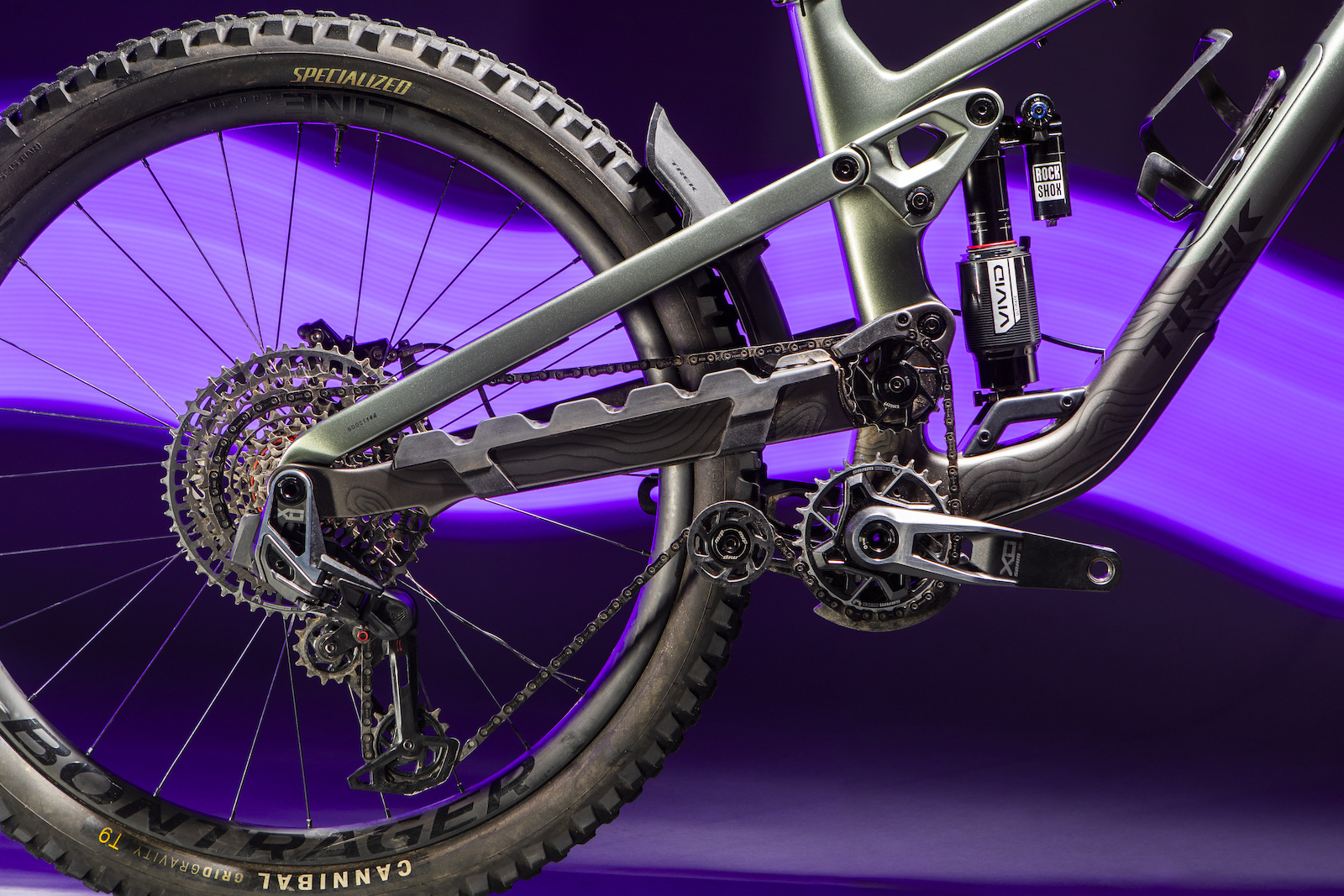
Cool Features
The New Trek Slash 9.9 Plows As Expected, But Pedals and Pops Too!

- Click to share on Facebook (Opens in new window)
- Click to email a link to a friend (Opens in new window)
I’m lucky to live in an area with delightfully steep and rough terrain. Because of that, long-travel bikes like Trek’s Slash are right up my alley. The 2024 Slash’s generation 6 frame is ready to get rowdy with a new high-pivot suspension linkage and 170mm travel. The bike simply plows through rough terrain, but remains impressively capable of getting itself back uphill for more laps.
The short story is I have nothing negative to say about Trek’s transition to the high-pivot suspension linkage. The new Slash is buttery smooth, yet offers a surprisingly poppy ride and still climbs as aggressively as their ABP bikes. The Slash is not the lightest bike, but that’s kinda fair since it’s such a beast.
2024 Trek Slash: Key Specs
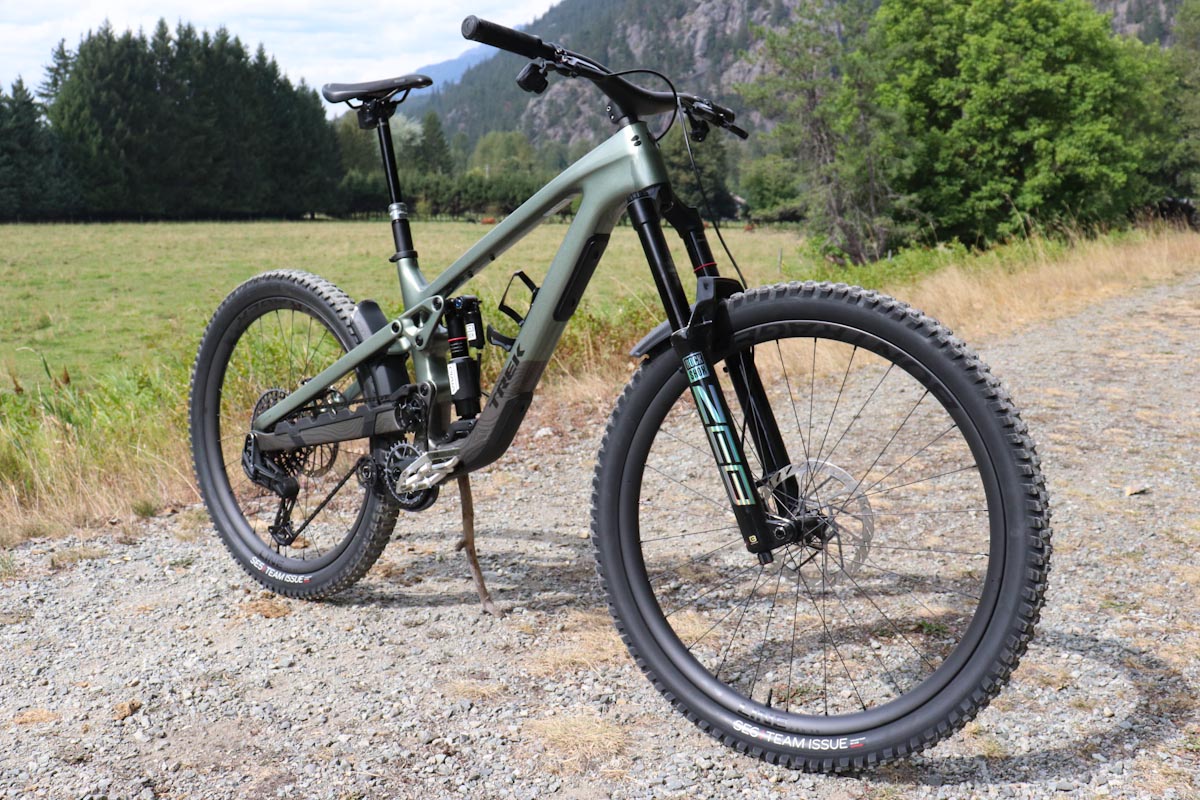
For full details on the new Slash lineup, check out my launch article from September. Before we get into the ride review, here are a few key specs and features of the 2024 Slash.
Most models of the Slash, including the 9.9 X0 AXS T-Type model I tested, come with full carbon frames. There are two aluminum complete models and an alloy frameset in the lineup. Of course, the biggest update for the Slash is the high-pivot linkage. The Slash now offers 170mm rear travel and all models come with 170mm forks.
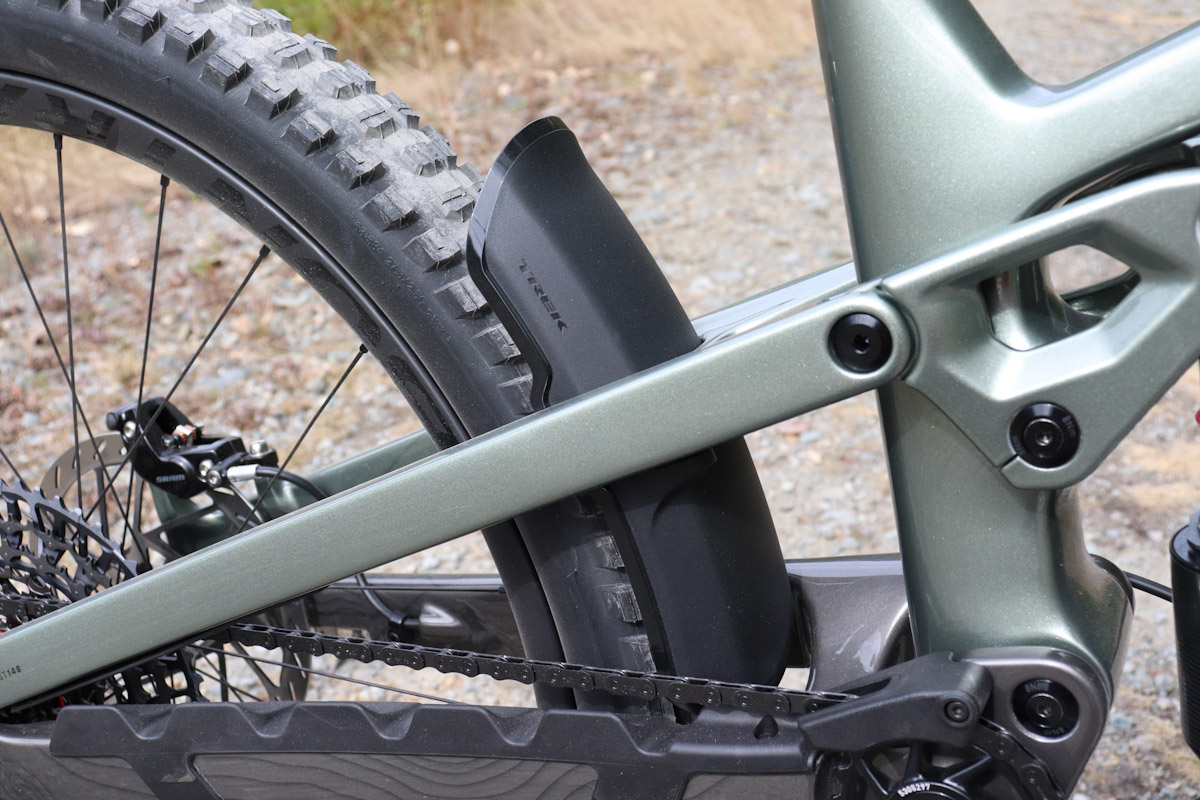
Another interesting change for the new Slash is that they all come stock with a mixed-wheel setup (except small frames, which run dual 27.5” wheels). Frame sizes medium and up can run a 29” rear wheel, but you must buy the geo-correcting shock mounts from Trek. You’ll also have to remove the rear fender, as it doesn’t leave enough clearance for the 29” rear wheel.
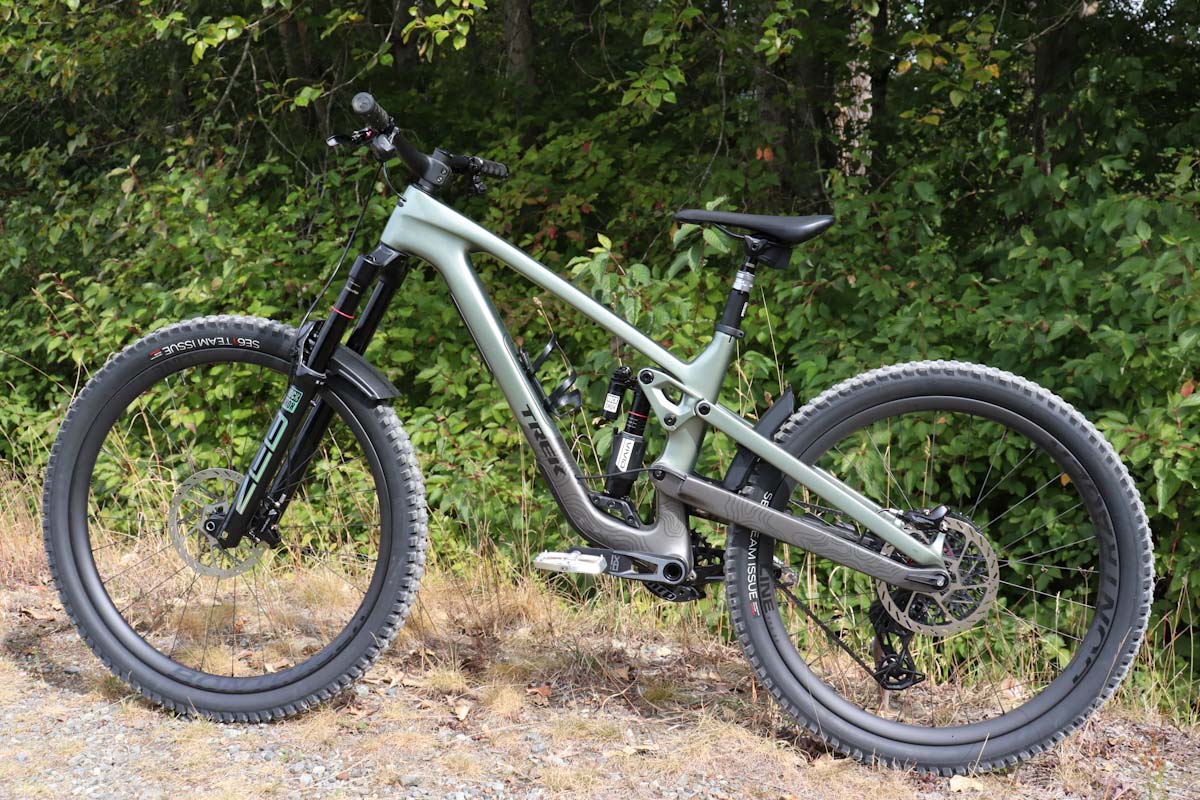
The Slash boasts very slack and adjustable head tube angles, which can be altered by adding Trek’s angle adjust headset cups. Trek also incorporated their leverage rate chip into the shock mounts, offering ‘less’ and ‘more’ progressive settings. The Slash does not have Trek’s mino link anymore, as the other adjustments offer plenty of opportunity for fine tuning. Trek also decided to do away with their Knock Block headset.
A nice finishing touch for the carbon-framed Slash is Trek’s new ‘Carbon Armor’ frame protection. Before they’re painted, Trek wraps the frames with an impact-resistant film.
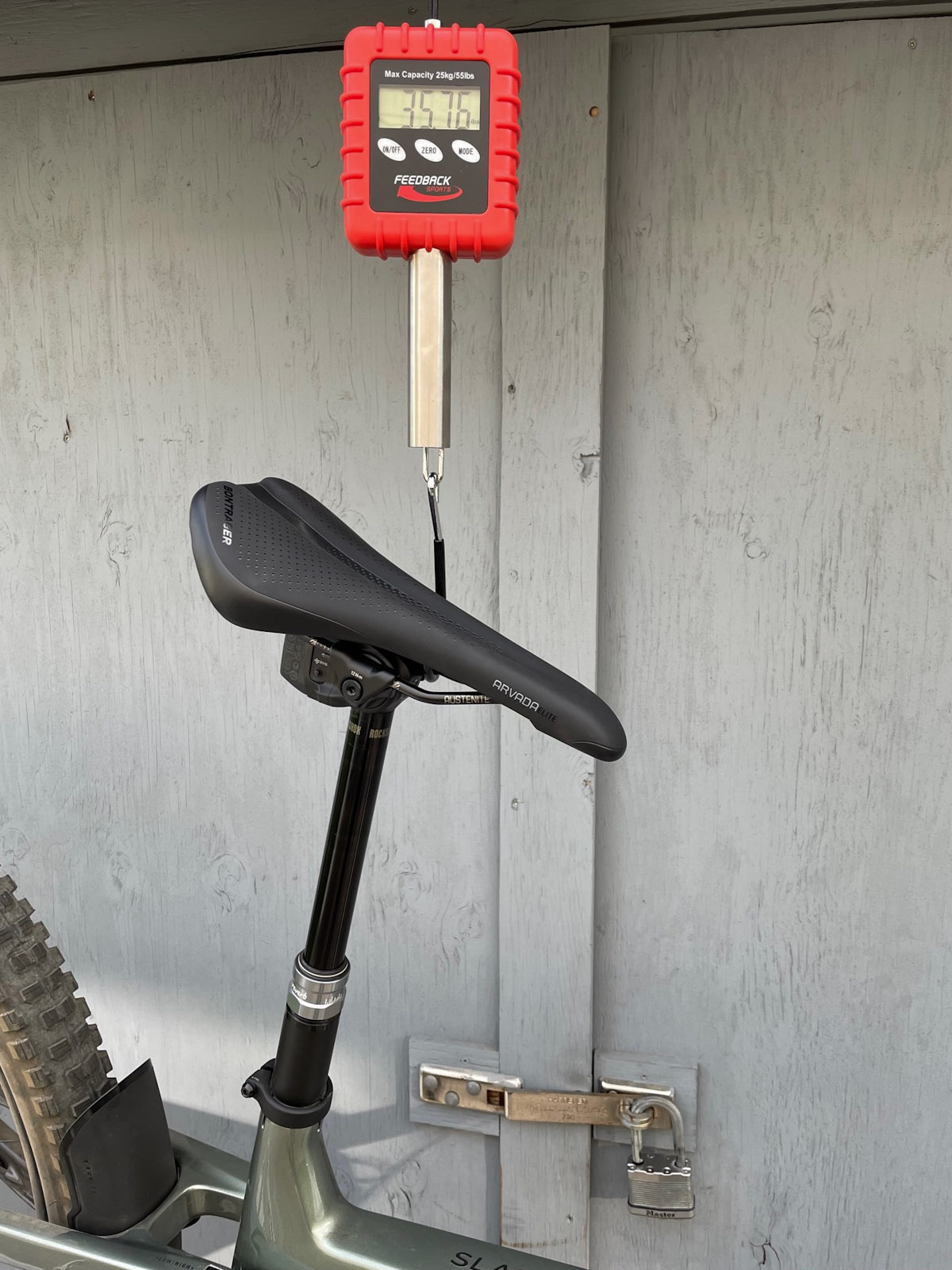
The Slash 9.9 X0 AXS T-Type (size M/L) weighs 35.76 lbs with pedals. Considering this is a beastly 170mm travel bike, and has extra hardware for its high pivot linkage, I guess I couldn’t hope for much better. I have to say though, with a full carbon frame, carbon rims and a lightweight carbon bar/stem combo, I was a bit surprised to see this high-end model come in over 35lbs.
Geometry/Fit:

At 5’10” and riding a M/L frame, I’m very happy with the Slash’s geometry. For this article, I’ll discuss the geo of my test bike, which has neutral headset cups and its stock mixed-wheel setup. Unfortunately, I didn’t have a compatible 29” rear wheel on hand to test.
So you know, the geometry remains very similar if you install a 29” rear wheel. Aside from the chainstay length growing by 6mm, there are very minor differences in certain angles and measurements. Check out Trek’s website to see all the different geo charts.

My test bike’s head tube angle is 63.3°, and I loved it. The slack steering angle tackles steep and rough terrain like a champ, but as I’ve found with slacker long-travel bikes it doesn’t hamper climbing ability by much. I’m not sure if I would go any slacker for trail riding, but if I set up a Slash for bike park shredding I’d be tempted to try the slacker headset cups. At 63.3° the Slash offers a ton of stability and feels great on steep downhills, yet the bike still doesn’t feel overly long or clumsy on tight switchbacks.
Helping get you uphill is a steep effective seat mast angle of 77.3°. With a lengthy reach of 468.1mm, that steep seat tube leans you into a well-balanced position over the bike. This is one of the longer bikes I’ve ridden, but I never felt like my arms were overextended.
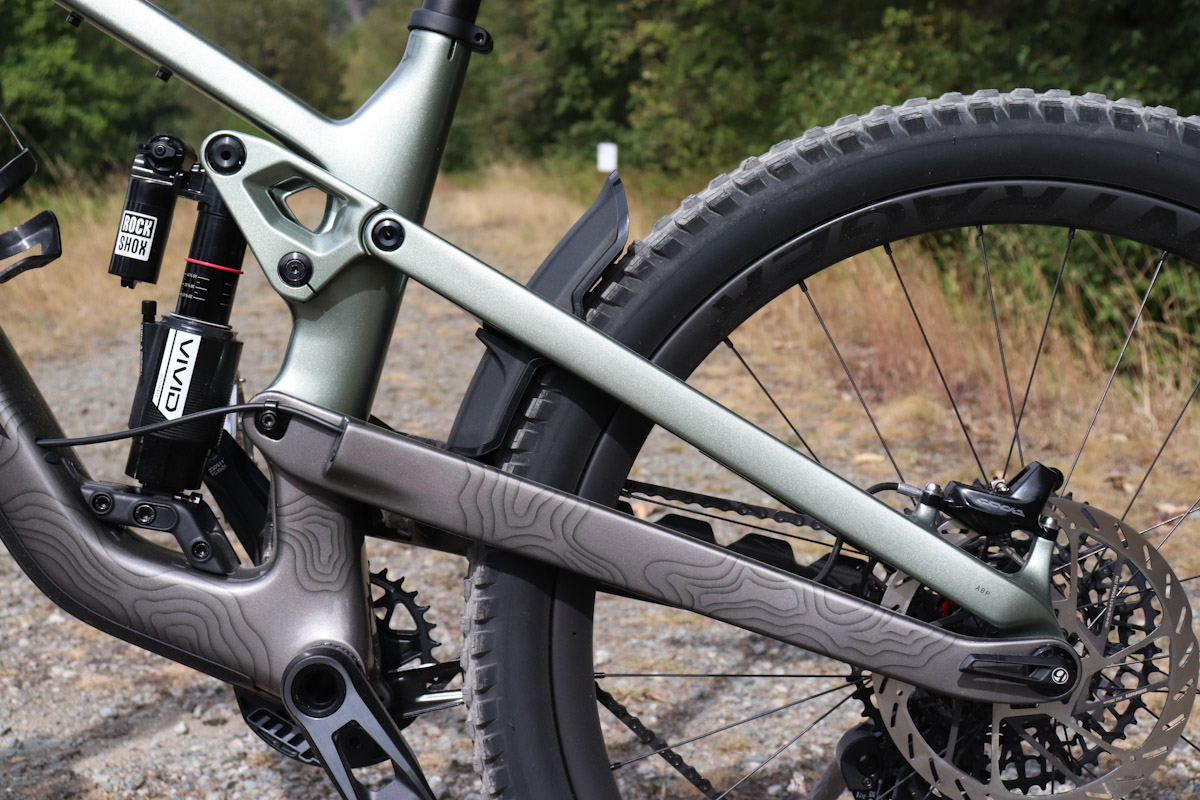
With Trek’s size-specific chainstays, the M/L mixed-wheel Slash’s rear end measures 434.2mm. This middle-of-the-road length, especially with the 27.5” rear wheel, keeps the Slash pleasantly agile. Overall the bike feels long and very stable at speed, but the rear end simply whips around corners. I should note this is the first MX bike I’ve ridden, and I quickly understood why people like them. I’ve never been amazing at cornering, but I felt like I suddenly got better when I hopped on this bike!
Looking at the numbers, the Slash isn’t the lowest bike out there. The standover height is not particularly low at 766mm, and neither is the BB height of 351mm. Up front the stack height is 632.1mm. I don’t remember banging pedals or the 165mm cranks very much, so the BB height allows decent clearance on the trail. It’s higher than some competitors, but the Slash’s long wheelbase and slack steering still provide a very stable ride.
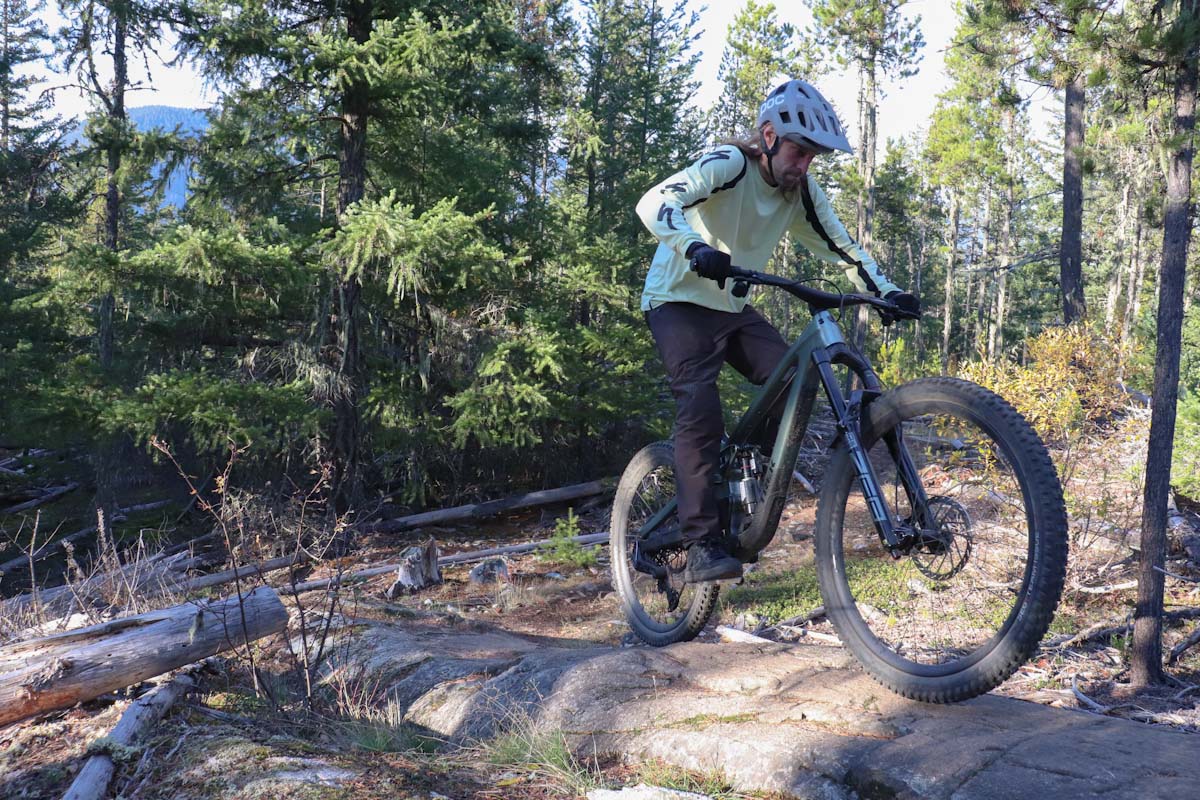
On my first ride with the Slash, I did notice the slightly sluggish roll of the 27.5” rear wheel. I had been riding niners for a few weeks before the Slash arrived, and I have to admit I felt the difference right away.
That said, I quickly forgot about the smaller rear wheel and adapted to the Slash’s ride. While I’ll never say it’s the best climber I’ve ridden, it does very well for how burly a bike it is. Shedding some weight and running 29” wheels would make it climb better, but that’s not what the Slash is all about. Trek describes this bike as ‘70% downhill, 30% uphill’ but I’d say it climbs a little better than that suggests.
I’ve always found Trek’s ABP linkage to climb aggressively and powerfully, and the new high-pivot version doesn’t behave too differently. Trek tuned the new Slash’s anti-squat to be pretty close to their Top Fuel XC/trail bike, so your pedalling inputs won’t force you deep into the Slash’s lengthy travel.
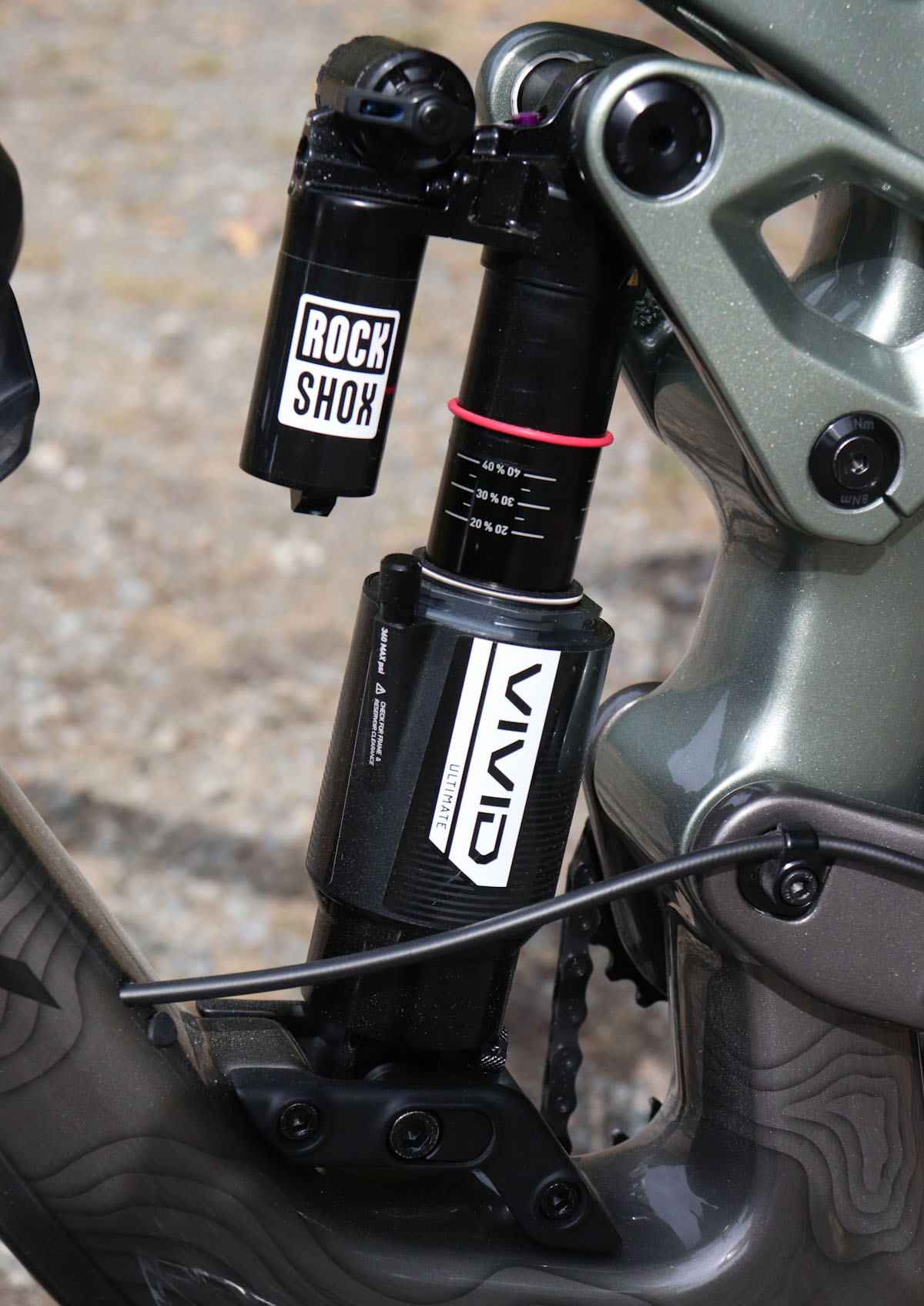
Climbing singletrack with the shock in firm, I’d get about 50% travel. In open mode, the shock would dip a bit further but top out around 60-65%. I’ll take the slightly rougher ride and increased pedal support from the shock’s firm mode, because in either setting I had solid traction on any singletrack climb. In firm mode the Slash doesn’t erase small bumps; you still feel the trail below you with the shock resisting those low-speed impacts.
In open mode, the shock helps soften those small bumps and offers a more comfortable ride. Fortunately, there is little sacrifice in pedalling efficiency when the shock is left open, so riders looking for maximum traction can opt to climb this long-travel machine wide open with practically no penalty.

With the rear shock left wide open, I tried some hard pedaling and sprinting on paved roads to see what the Slash’s high-pivot linkage would do. Sitting down and mashing the pedals as best I could, I could not get the bike beyond 40% travel (from 30% sag). Even standing up and sprinting, I only made it a bit further than 40%. It’s clear that Trek’s linkage handles pedaling forces very well. The bike was in its ‘more’ progressive position for this test, but I don’t think it would behave much differently in the ‘less’ setting so early in the travel.
It’s always nice when a bike has no unusual setup requirements. With the Slash, I pumped the shock up to body weight in psi, set rebound/compression to my usual ranges, and the bike was dialed. Right away I was getting full travel from the rear shock (with the leverage chip in ‘less’ position), which is sometimes an issue for my 145lbs self.
Descending:
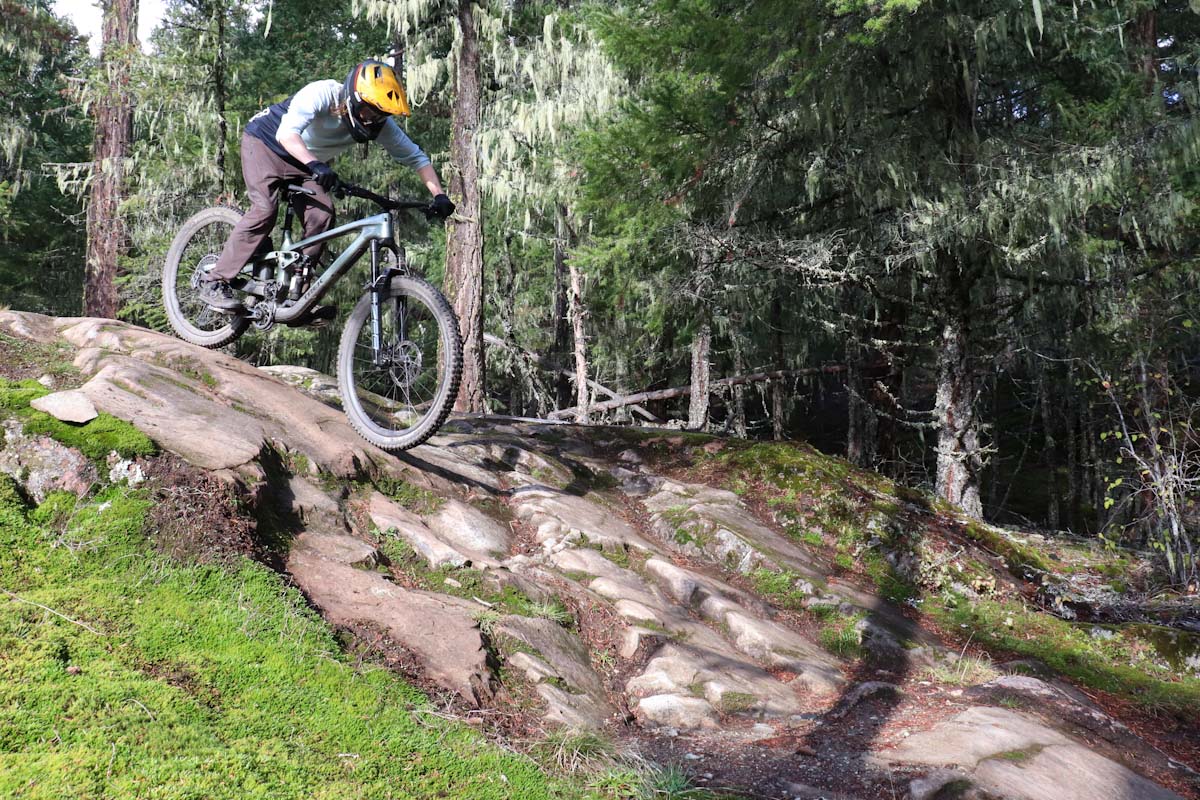
I’ve always found Trek’s MTBs to be great at gobbling up bumps, but the high-pivot Slash is even better. I noticed it does particularly well at eating up mid-sized bumps, happily plowing through roots and rocks. The rearward axle path does a great job of numbing bigger hits and keeping the Slash feeling planted on rough trails. I found the bike cushions landings very well, especially on little jumps that send you right onto a rocky or rooty patch.
It’s hard to pinpoint a weak spot in the Slash’s suspension. At higher speeds, the bike smooths out small bump chatter very well, and as noted above it rounds off medium and big hits nicely.
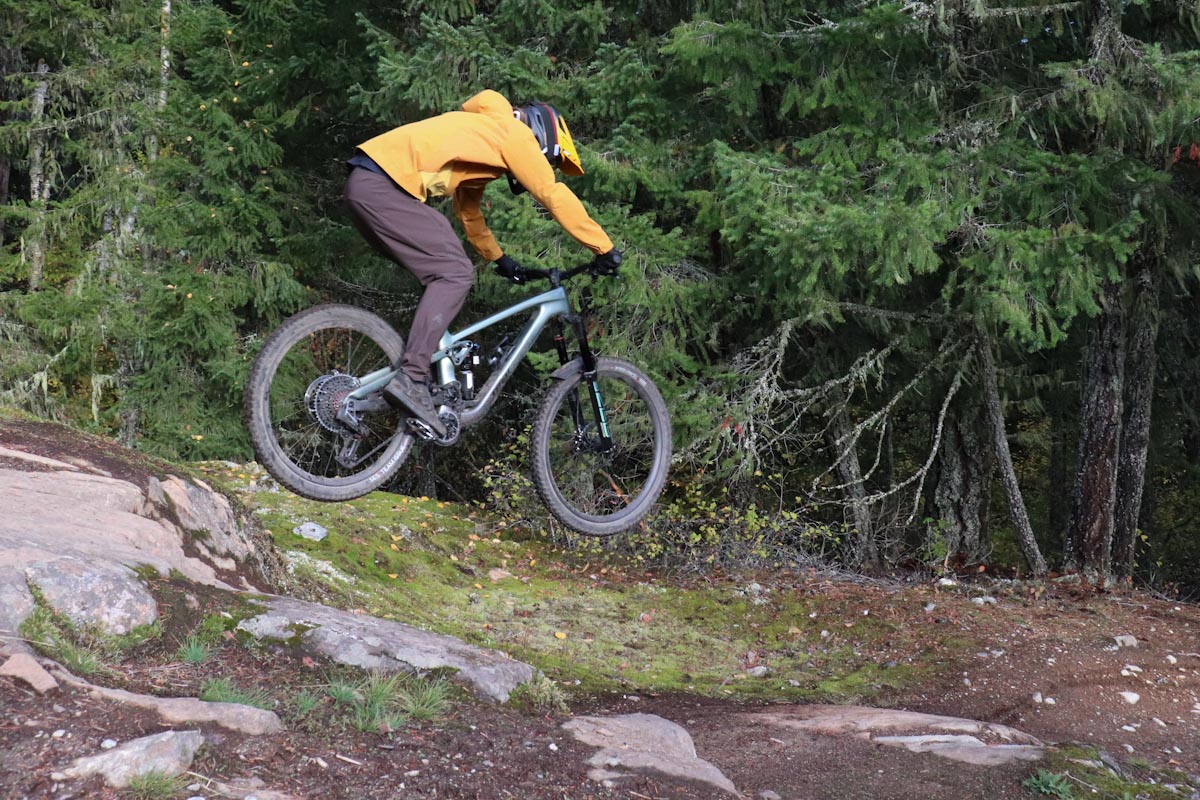
Furthermore, with all that squish when you want it, the Slash actually seems to pop off jumps a bit better than the 2019 Remedy I owned for several years. It also springs out of corners surprisingly well, as I’ve traditionally found Treks to be a better example of plowy than lively and poppy. It seems the big Slash has maintained an impressive degree of mid-stroke support.
Just looking at this frame, you’d probably expect it to be stiff and you’d be correct. Just like the previous generation Slash and Fuel EX I rode, I found the 2024 Slash’s frame offers a solid, commanding feel as you charge down rough trails.

For most of my rides, I had the leverage chip in its ‘less’ setting, but I flipped it to ‘more’ for my last few test laps. Interestingly, the ‘more’ setting doesn’t seem to increase bottom-out resistance by much; I hit full travel on a typical trail loop in the first ride in this setting.
What I found is the rear wheel does feel like it’s resisting bigger, sharper hits more. Under my lightweight self, the Slash felt a bit less plowy and the back wheel would bounce a bit more facing sharp impacts. The only time I got a good ‘thunk’ out of this bike’s rear end was while riding in the ‘more’ position. For me, there’s no question I’d keep the Slash in its ‘less’ setting. The biggest joy of this bike is how capably it sucks up rough terrain, and I’ll take all the squish it has to offer.
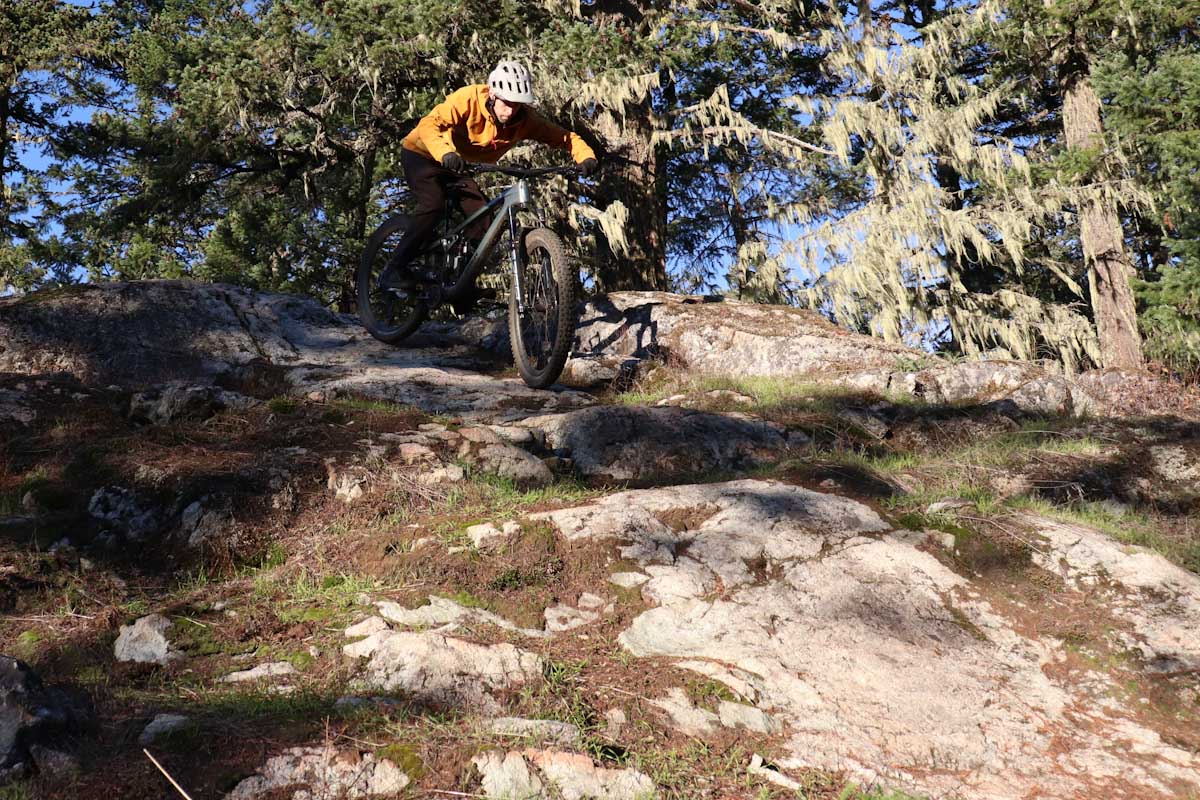
The Slash’s 27.5” rear wheel offers good clearance. I rode the steepest trail in my local network and didn’t hit my ass on the tire once (and I have on my personal 29er)! As mentioned above, the mullet setup also has an immediately noticeable benefit in the corners. After you initiate a turn, you then feel the back end hook in and bring you around quicker than a 29er would.
Chain Drop?

Some of you may have seen reports of the new Slash dropping chains. Apparently, some of the bikes were sent out with the lower chain guides incorrectly installed, and some riders had issues with chain drop. After many rides on my test bike, I got the notice from Trek and found out it was indeed not to spec… however I never dropped a chain.
By the time I got the info on how to correct the situation, winter had set in and my testing was pretty much done. I rode the bike two or three more times without even adjusting the chain guide, and still never once lost my chain.
To fix this issue Trek is making sure all Slashes will now be shipped out with the correct setup. They’ve also notified dealers on how to fix the issue, and as an extra precaution, they’re supplying upper idler pulleys with longer teeth to dealers at no charge. As of early 2024, anyone with a new Slash can go to their local shop and have the revised idler installed.
If you’re wondering about potentially increased drag with the high-pivot chain line, I can’t say I noticed anything measurable. Of course, this is a brand new bike; over time the upper pulley might produce extra drag if the bearing wears out, but with all new components the Slash pedalled like any other MTB.
Components:
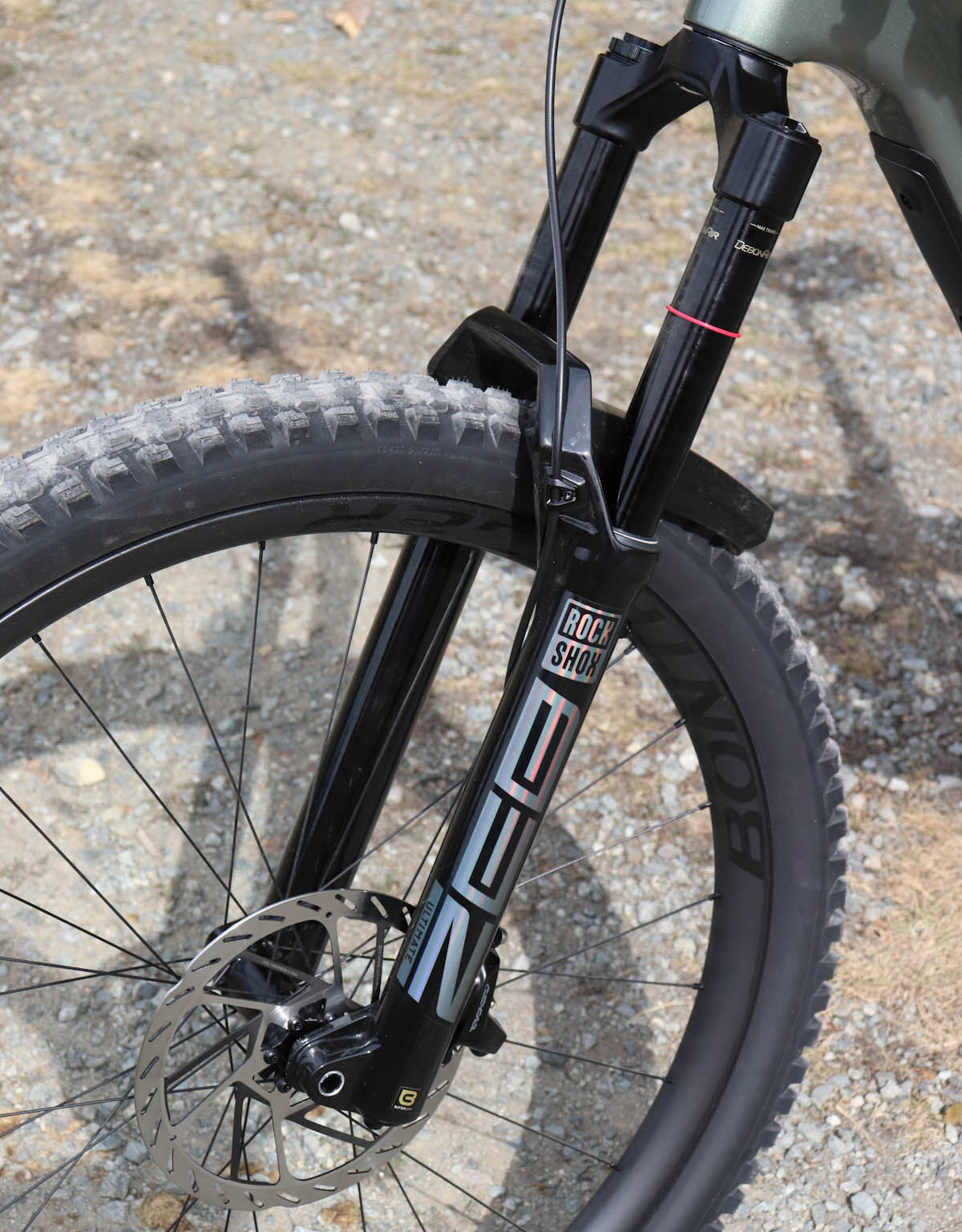
A RockShox Zeb fork was the obvious choice for the burly new Slash. The 9.9 X0 AXS T-Type bike I rode gets the Ultimate model with a DebonAir spring and Charger 3 RC2 damper. The fork is stiff, offers great initial sensitivity, and sucks up bigger hits in class-leading fashion.
Out back, RockShox’s Vivid Ultimate rear shock performed great with very little fidgeting. The stock tune feels pretty linear which works well for a smaller guy like me, allowing full squish on nearly any descent. The shock’s firm mode resists low-speed impacts nicely, but doesn’t ride like you’re at near-lockout firmness.
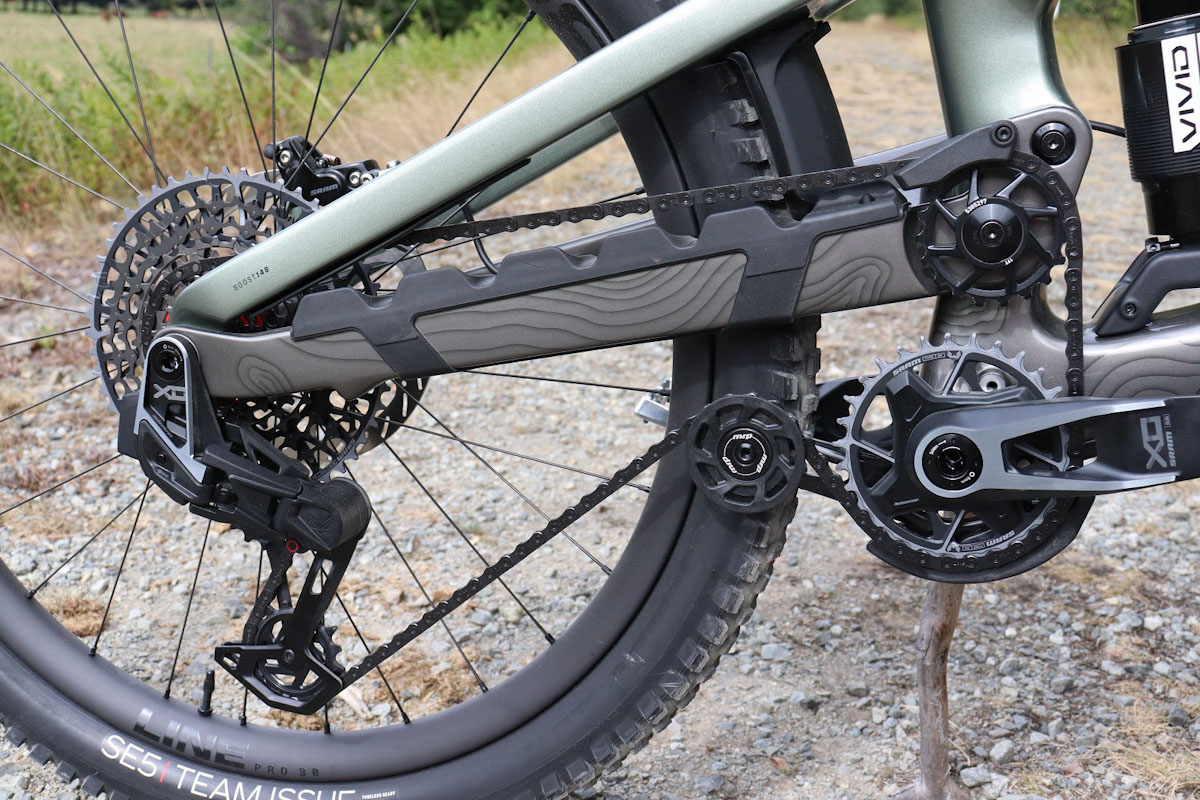
Overall I had great performance from the SRAM X0 Eagle AXS T-Type drivetrain and dropper post. However, the dropper post suddenly stopped working in the middle of my third ride. Once I got home I simply paired up the post and control pod, and since then everything has worked perfectly.
The 30t chainring and 10-52t cassette provide a vast gear range for trail riding, and shifting performance was basically flawless throughout my test. I unfortunately gave the T-Type X0 derailleur’s cage a good smash and a nasty bend, but didn’t notice right away because gear shifting was still fine! The derailleur will skip lightly when backpedaling but it still doesn’t derail at all, which is impressive.
Bontrager’s Line Pro 30 carbon wheels held up great through my test, showing no signs of damage or warpage. The Slash’s wheels come tubeless with a Bontrager SE6 Team Issue 29×2.5” front tire and a Team Issue SE5 27.5×2.5” rear tire. These tires offer a well-rounded tread that rolls fairly fast and provides good grip on all surfaces.
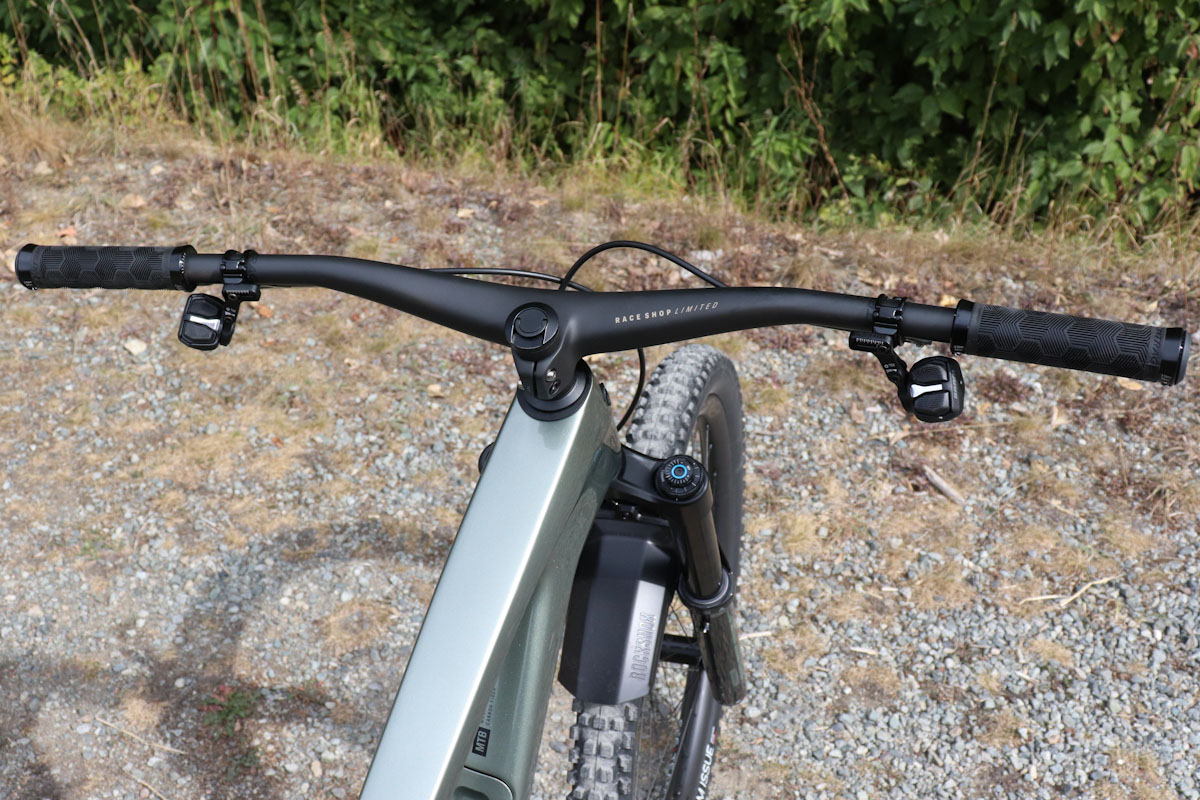
Bontrager’s RSL carbon bar/stem combo is hard not to enjoy looking at! The rise is 27.5mm, stem length is 35mm, and the bars come stock at 820mm wide . The 7° backsweep and 6° upsweep is a bit more up and less back than most bars I’ve ridden, but I found them comfortable. I would have liked to ride the full width, but my bars had been cut to 795mm. I rode these bars uncut on the previous generation Slash and was surprised how much I liked them.
SRAM’s Code Silver 4-piston brakes with 200mm rotors had no shortage of power, reeling in this big bike with great modulation and more than ample bite force.

The 170mm dropper post on the M/L frame gets low and out of the way. I didn’t have any problems riding with the Bontrager Arvada saddle, but I find it a bit hard and not the most comfortable.
The Slash’s rear fender seems to work fairly well. After a wet, snowy ride I still had mud spray all the way up the back of my jacket, but less than what I expected. I also noticed the back of the dropper post and under the saddle weren’t that dirty.

Trek’s Carbon Armor seems to help resist frame damage well. After close inspection, I could only find a few very minor knicks or scratches on the Slash. The down tube, BB shell and all the areas prone to rock strikes from the rear wheel remain basically unscathed.
Frame Storage:

Trek’s in-frame storage was revised for the Slash, offering a larger door and an updated latch. The storage compartment is easy to open and close, and the included Bontrager BITS tool roll has spots for a CO2 canister, an inflator head, a multi-tool, and a tube (although it’ll have to be a thin one). Trek added ‘chunnels’ inside the Slash’s frame to keep your tool roll/cargo from snagging on your cables. They seemed to work well, I had no issues with anything snagging inside the frame.
Bontrager’s BITS steerer tube multi-tool is also included on all Slash 9.9 models – a nice finishing touch for these top-tier builds!
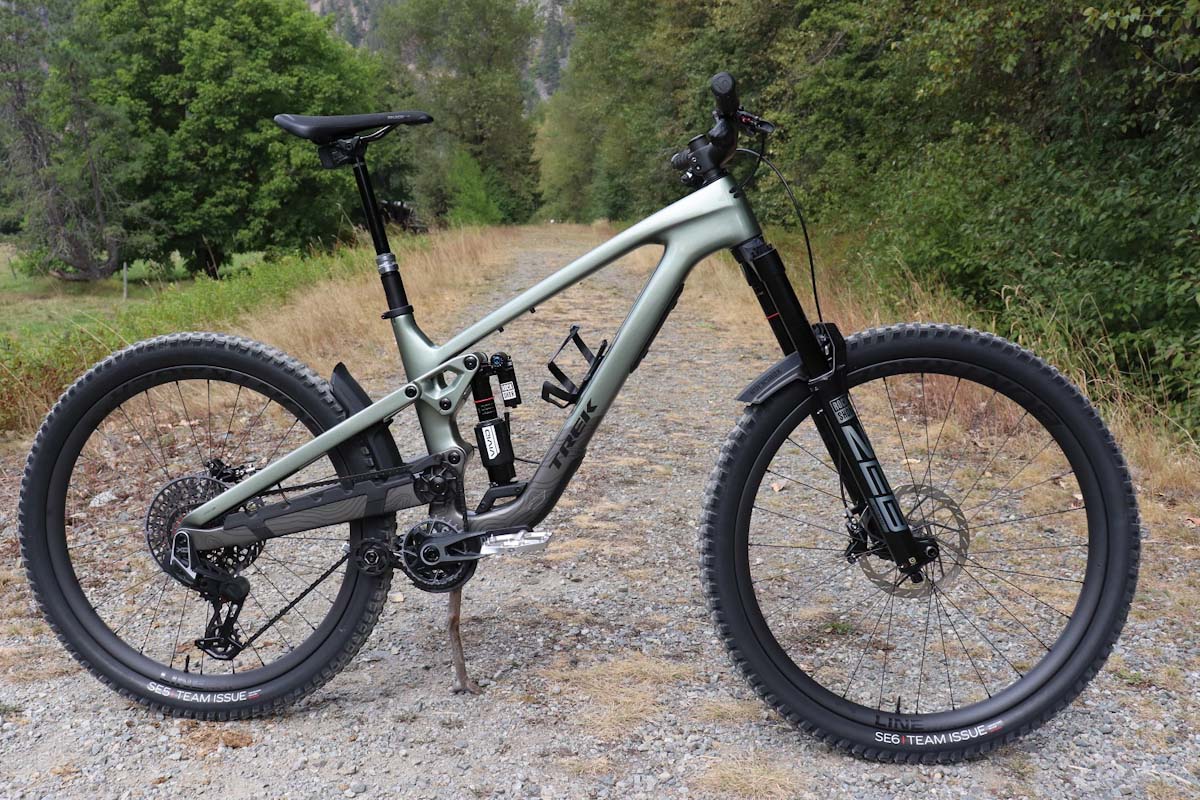
The 2024 Trek Slash 9.9 X0 AXS T-Type retails for $9399. Frame color options are Daintree, Lichen Green (as tested), or Argent Drizzle.
trekbikes.com

Steve Fisher is a staff contributor for Bikerumor. Steve has been writing about trail, enduro and downhill mountain biking (plus a few commuter bikes) for seven years. Prior to that, Steve wrote for Whistler Traveller Magazine and Mountain Life Magazine. Steve is based in Pemberton, British Columbia, an area that offers plenty of challenging world-class singletrack and makes for great photos!
This site uses Akismet to reduce spam. Learn how your comment data is processed .
what a contraption
Follow Us On
Subscribe Now
Sign up to receive BikeRumor content direct to your inbox.
Why Star Trek's Trill Mysteriously Sprouted Spots When It Came Time For Deep Space Nine

The Trill were first introduced in the "Star Trek: The Next Generation" episode "The Host" (May 11, 1991). In that episode, Dr. Beverly Crusher (Gates McFadden) engaged in an intense love affair with a Trill super-diplomat named Odan (Franc Luz), a man whom she later discovered had a very unusual biology. It seems some members of the Trill species are joined with incredibly long-lived worm-like symbionts that are surgically implanted in their stomachs. The symbionts possess the memories and experiences of all their hosts and take over the personalities of the people they are implanted inside of. Symbionts can live through dozens of hosts in their lives.
In "The Host," Odan sported inverted v-shaped forehead ridges above his eyes and a larger, extended septum. The makeup was designed by Michael Westmore, a longtime "Next Generation" makeup artist.
It wouldn't be until "Emissary" (January 3, 1993), the pilot episode of "Star Trek: Deep Space Nine," that Trekkies would encounter another Trill. "DS9" featured a Trill character named Jadzia Dax (Terry Farrell), who served as Deep Space Nine's science officer. In the lore of the series, Jadzia had recently been given the Dax symbiote after it spent many decades inside the body of a party-loving old man named Curzon. Jadzia had to reconnect with several old friends who knew her from her previous life.
Dax, one might immediately note, doesn't have the same forehead ridges that Odan did. It seems that the makers of "Deep Space Nine," after trying out similar ridges on Farrell, elected to do something less obtrusive. According to Paula M. Block's and Terry J. Erdmann's book "Star Trek: The Next Generation 365," Dax's makeup artists modeled her new "spots" after Westmore saw how good they looked on Famke Janssen in the "Next Generation" episode "The Perfect Mate" (April 27, 1992).
Famke Janssen, the perfect mate
Resourceful Trekkies can likely find the early makeup tests that Terry Farrell went through for "Deep Space Nine." It seems that the original Dax makeup design was to give her Odan's forehead ridges but to make them less pronounced . The reason for a more "subtle" version of the makeup was likely twofold. For one, the series already featured numerous alien characters that required hours-long makeup jobs, and having one fewer was cheaper. It's also likely that someone didn't want the actor's face covered. According to the "365" book, the studio in particular didn't want an attractive actor like Farrell to sport a weird alien forehead. A redesign of the Trill makeup was required.
Westmore recalled doing makeup for "The Perfect Mate" and was inspired. In that episode, a woman named Kamala (Famke Janssen) is being transported in stasis to a diplomatic summit where she will offered as a bartered bride. Kamala's arranged marriage with a distant politician will, it is hoped, end a generations-long war. Naturally, Kamala — having been released from stasis early by accident — accidentally bonds with Captain Picard (Patrick Stewart). Kamala was depicted as being romantically and sexually irresistible, and her makeup was meant to reflect that. Westmore was fond of her look, which incorporated a series of small red spots on Kamala's temples.
That look was recreated for Dax and even expanded. Dax had a complex series of spots that ran down her temples and down her neck. A flirtatious alien once asked Dax how far down the spots go, and she winkingly replied, "All the way."
The new Trill look worked well. It denoted that she was an alien, but more subtly than the show's Changeling or Ferengi characters.
The continuity headache
Sadly, the new makeup design caused no small amount of headaches for Trekkies obsessed with continuity (which is to say, most Trekkies). In "The Host," both Odan and the eventual second host of his symbiont (played by actor Nicole Orth-Pallavicini) had the ridged forehead and pronounced septums. After that, all Trill had the temple spots, even into the days of "Star Trek: Discovery." There has never been a canonical reason for the change, and no characters have ever commented that Trill used to look different.
It is, frustratingly, just another changed "Star Trek" premise that fans merely have to accept. For many years, for example, Klingons looked like humans, only sporting Fu-Manchu-style mustaches. In "Star Trek: The Motion Picture," they suddenly had outsize forehead ridges. In "Next Generation," their foreheads were enormous, and in "Discovery," they sported either jet-black or pearl-white skin, elongated skulls, new eyeballs, and even extra nostrils. These kinds of changes are done for the benefit of the showrunners' creativity and typically serve to make fans squirm uncomfortably. Something similar happened with the Romulans as they moved from the original "Star Trek" to the days of "Next Generation."
Of course, with the Klingons, their change was eventually addressed . A multi-part episode of "Star Trek: Enterprise" explained that the "Original Series" Klingons were infused with enhanced human DNA. That DNA would eventually be bred out of Klingons in a few generations, hence they looked the way they did in "Next Generation."
Given the attention to detail some "Trek" writers pay, it's likely a future episode will explain away the Trill foreheads in earnest.
Some products listed on this page may be available only in select markets. Please refer to your local Trek retailer to confirm availability and date of release in your country or region.
Bike manuals
Trek bicycle owner’s manual.
This bike manual comes as standard on most makes and models of Trek bikes.
- Supplemental info: Stems
- Supplemental info: Tools
- Supplemental info: Riding Tips
- Supplemental info: Fitting Your Bicycle
- Supplemental info: Mechanical Warning
- Supplemental info: Lubrication
- Supplemental info: Torque
Additional Trek bicycle manuals
2024 bike manuals and guides, 2023 bike manuals and guides, 2022 bike manuals and guides, 2021 bike manuals and guides, 2020 & older bike manuals and guides, gary fisher, electric bikes, suspension setup guides.
- 2009+ Suspension Set-up Calculator
- Suspension Set-up Video (YouTube)
Computer manuals
Bontrager computers, trek computers, light manuals, current product manuals, previous generation manuals, tube, tyre and wheel manuals, brakes manuals, pump manuals, helmet manuals, shoe manuals, handlebar manuals, seatpost manuals, bicycle rack manuals, lubricants, solvents and touch-up paint, lock manuals, accessories.

IMAGES
VIDEO
COMMENTS
2023 Bike manuals and guides. Service manual - 2023 Allant+ 5 / 6. Service manual - 2023 Domane SL / SLR Gen. 4. Service manual - 2023 Domane+ AL. Service manual - 2023 Domane+ SLR. Service manual - 2023 Emonda ALR. Service manual - 2023 Farley Alloy. Service manual - 2023 Farley Carbon. Service manual - 2023 Fetch+ 2.
You're looking at the United Kingdom / English Trek Bicycle website. Don't worry. We've all taken a wrong turn before. ... Additional Trek bicycle manuals. 2024 Bike manuals and guides. 2023 Bike manuals and guides. 2022 Bike manuals and guides. 2021 Bike manuals and guides. 2020 & Older Bike manuals and guides.
The Trek Slash C Gen 5 is a bicycle designed for off-road performance. It features a sturdy and durable frame, ensuring reliability during intense rides. The bike is equipped with high-quality components, providing a smooth and efficient riding experience. With its advanced suspension system, the Trek Slash C Gen 5 offers excellent control and ...
The Trek Slash AL Gen 6 is a mountain bike designed for off-road adventures. It features a sturdy aluminum frame that provides stability and durability during intense rides. The bike's design allows for precise handling, making it suitable for both technical trails and fast descents.
The Trek Slash AL Gen 5 is a bicycle that offers a reliable and durable riding experience. It is made with high-quality materials that ensure its longevity and strength. Specifically designed for optimal performance, the Trek Slash AL Gen 5 is built with precision to meet the needs of serious riders. It features a sturdy frame that provides ...
Built burly. 1. Sitting at a relaxed 63.5-degrees, Slash's head tube keeps your front wheel far ahead for serious stability on the steepest, gnarliest trails. 2. Perched at 77-degrees, Slash keeps you in the perfect position for putting down power on long slogs up fire roads and punchy, slabby climbs. 3.
The Trek Slash AL Gen 5 is a mountain bicycle that offers a reliable and durable option for riders seeking adventurous off-road experiences. Designed with precision and constructed with high-quality materials, this bike guarantees longevity and performance. The slash AL Gen 5 features a sturdy frame that provides stability and control on rough ...
The Trek Slash AL Gen 6 is a bicycle that offers a reliable and durable riding experience. Designed with high-quality materials, this bike is built to last. One notable feature of the Trek Slash AL Gen 6 is its optimized geometry. This allows for enhanced stability and control while riding, making it suitable for various terrains and riding styles.
View the manual for the Trek Slash C Gen 5 here, for free. This manual comes under the category bicycles and has been rated by 1 people with an average of a 9.1. This manual is available in the following languages: English. Do you have a question about the Trek Slash C Gen 5 or do you need help? Ask your question here
All-new frame with a high pivot suspension design. - Updated, slacker geometry and optional angle adjust headset cups. - Increased rear travel from 160mm to 170mm. - Leverage rate adjust chip. - Stock mixed-wheel builds (29" front, 27.5" rear) on all sizes except S (27.5" front and rear) - Updated frame protection with Integrated Carbon ...
View the manual for the Trek Quadro Slash C here, for free. This manual comes under the category bicycles and has been rated by 1 people with an average of a 7.4. This manual is available in the following languages: English. Do you have a question about the Trek Quadro Slash C or do you need help? Ask your question here
We have 1 Trek Slash Alloy and Carbon - Gen 6 manual available for free PDF download: Service Manual Trek Slash Alloy and Carbon - Gen 6 Service Manual (23 pages) Brand: Trek | Category: Bicycle | Size: 18.12 MB
Slash is a no-holds-barred long-travel enduro bike built for ripping through the rowdiest terrain. Slash Gen 6 delivers for seriously aggressive riders, with 170mm of front and rear travel, tons of adjustability, and a high-pivot suspension platform - plus mixed wheel sizing for getting extra wild. Want something a little lighter?
Bicycle Trek Ride+ Owner's Manual. Pedelecs and fast electric bikes (40 pages) Bicycle Trek Ride Plus Owner's Manual. (148 pages) Bicycle Trek FUEL EXE 2023 Service Manual. (23 pages) Bicycle Trek 2022 CHECKPOINT SL Service Manual Supplement. (20 pages) Bicycle Trek FAZUA Owner's Manual.
Related Manuals for Trek Slash Alloy and Carbon - Gen 6. Bicycle Trek DOMANE AL GEN 4 Service Manual. 2024 (12 pages) Bicycle Trek Powerfly Gen 3 FS 9 EQ Service Manual (16 pages) Bicycle Trek Carbon Rail 9.8 Gen 3 2022 Service Manual Supplement (16 pages)
The 2021 Trek Slash bumps up the suspension travel, tweaks the geometry, and introduces a new rear shock. Trek Slash overview. Given the evolving demands of enduro racing, enduro bikes need to evolve too. Taking on board these changes, the new Trek Slash has had a 10mm lift in travel at both ends, and now features a 170mm fork matched to 160mm ...
Slash 8 Gen 5. 26 Reviews / Write a Review. $3,649.99 $4,299.99. Model 5274494. Retailer prices may vary. Slash 8 is an enduro mountain bike that rolls on fast 29er wheels and floats on plush RockShox suspension with SRAM's 12-speed GX Eagle handling drivetrain duties. An aluminum frame with fresh new tech and tough alloy wheels push this bike ...
This manual covers all Trek bicycle models. It contains useful information for the life of your bicycle. Read the fundamentals Read Chapter 1, Fundamentals, before you ride your bike. If you've purchased an electric-assist bicycle (e-bike), please also read the quick start guide and the supplemental Electric Bicycle Owner's Manual. They are ...
The Slash was updated for 2021 with 10mm more travel, along with the expected longer, slacker geometry changes, and a few bonus frame features. It's still rolling on 29" wheels, with 160mm of ...
Updated for 2023, the high pivot Trek Slash Gen 6 can be run with a number of wheel size configurations and can take up to a 190mm travel fork but comes with a 170mm fork and mixed-wheel setup as standard. Riders can choose a full 29er race machine, 27.5" aggro-shredder or put a dual crown 190mm with a mullet and have a mini-Session bike park ...
1. rjmogul (Oct 30, 2023 at 13:23) not surprising because the others are far from conventional, the Slash is much more closer to conventional than any of the other in this test. 15 10. alexsin ...
Trek also decided to do away with their Knock Block headset. A nice finishing touch for the carbon-framed Slash is Trek's new 'Carbon Armor' frame protection. Before they're painted, Trek wraps the frames with an impact-resistant film. The Slash 9.9 X0 AXS T-Type (size M/L) weighs 35.76 lbs with pedals.
Star Trek's Big Decision Makers Listen To Fans - Just Not The Toxic Ones. Paramount+. By Jeremy Mathai / March 29, 2024 6:00 pm EST. Ah, the wonders of the internet. When humanity first ...
Kelleruns Explained. A new face has joined the ensemble for the final season of "Star Trek: Discovery," along with a seemingly familiar set of pointy ears. A character named Captain Rayner (Callum ...
Here we go again. (I'm quoting the wrong sci-fi franchise, I'm aware, but stay with me.)In a massive cover story titled "The Future of 'Star Trek': From 'Starfleet Academy' to New Movies and ...
According to the report, fans can expect the movie to "serve as an origin story of sorts for the main timeline of the entire ['Star Trek'] franchise ." What that means, of course, is anybody's ...
She will be placed in charge of Section 31, a super-secret "Star Trek" version of the CIA. At last report, no story or characters had been revealed, although the cast was announced to include ...
It wouldn't be until "Emissary" (January 3, 1993), the pilot episode of "Star Trek: Deep Space Nine," that Trekkies would encounter another Trill. "DS9" featured a Trill character named Jadzia Dax ...
You're looking at the Australia / English Trek Bicycle website. Don't worry. We've all taken a wrong turn before. ... Additional Trek bicycle manuals. 2024 Bike manuals and guides. 2023 Bike manuals and guides. 2022 Bike manuals and guides. 2021 Bike manuals and guides. 2020 & Older Bike manuals and guides.